Introduction: Going Global
For years, China’s adaptive and largely successful system of domestic Internet censorship, known colloquially as the “Great Firewall of China,” has been held up as an example of how authoritarian regimes might—against all expectations—successfully manage the political impact of information and communication technology.1 Now well over a decade old and still evolving, the Great Firewall has largely contained politically significant information and collective action, while still allowing the vast majority of Chinese Internet users to access their own social networks, entertainment, and some forms of news.
But China is no longer content to simply manage the information space within its borders. Without much fanfare, it has turned its focus outward, seeking to take its influence over the information environment global. Through a combination of market-oriented mechanisms, propaganda, pressure tactics, and action in international arenas, China is attempting to harness the global information ecosystem in unprecedented ways. It has focused primarily on three avenues: shaping international news media, guiding the evolution of the global Internet, and influencing global culture through Hollywood. The cumulative effect of this global reach has yet to be fully dissected or understood.
China’s multifaceted effort reflects a modern, nuanced comprehension of what constitutes power in the information age. In utilizing the global information ecosystem, China is certainly not alone among authoritarian governments—Russia’s disinformation campaigns have certainly dominated more recent news cycles. But China now represents the most comprehensively successful authoritarian power in this respect, and serves as an example to others that might emulate its efforts. While Beijing claims it does not seek to promote its own political system, its successes can encourage other authoritarian regimes through the power of example, which in turn can help roll back existing democratic institutions and ensure international institutions are not weighted in favor of democracy.2 Such efforts can have important and long-lasting effects on democracy worldwide and on the current structure of the international order.
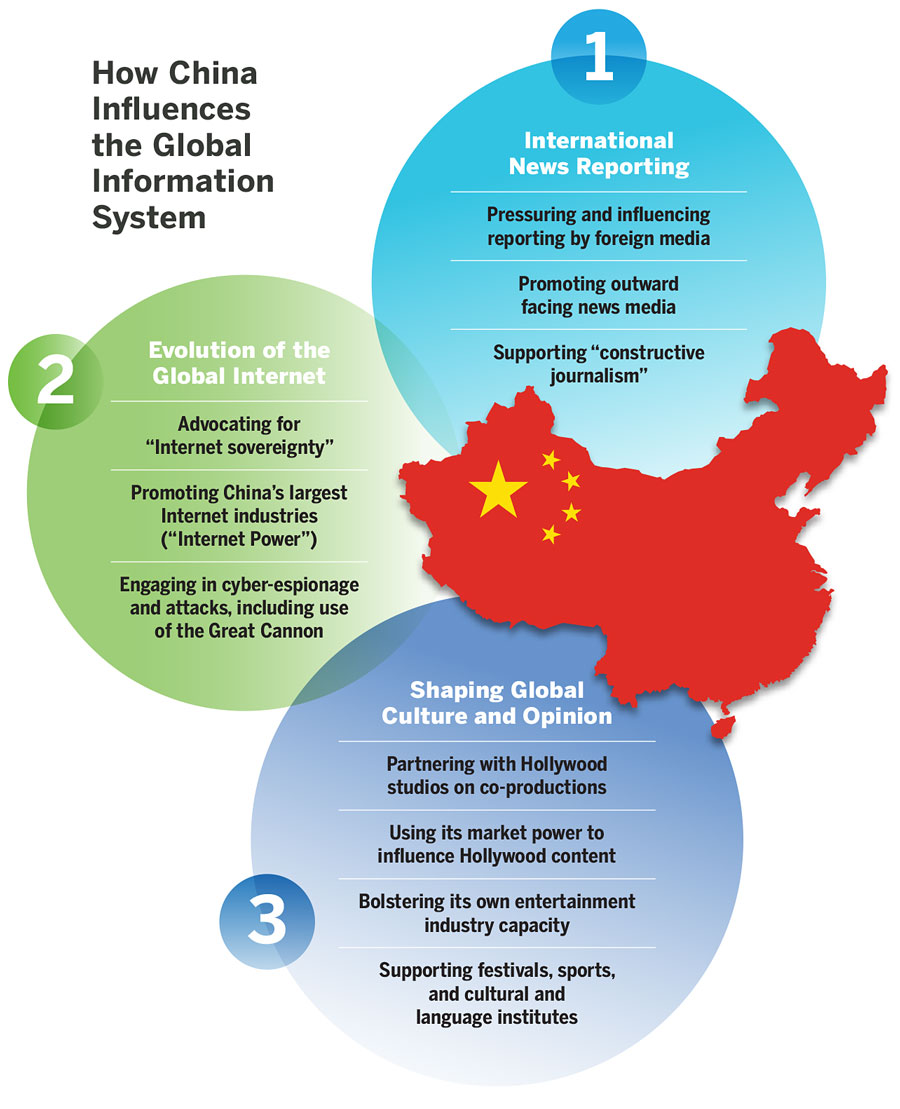 This paper seeks to shed light on this effort, looking specifically at China’s strategies to influence three aspects of the global information sphere.
This paper seeks to shed light on this effort, looking specifically at China’s strategies to influence three aspects of the global information sphere.
1. International news reporting. China’s efforts to promote international news coverage favorable to its interests can be divided broadly into three main categories: pressuring and influencing reporting by foreign media; promulgating its own outward-facing news media to foreign audiences; and influencing the structure and values of the media in countries where it has particular influence.
2. The evolution of the global Internet. China, along with other authoritarian countries such as Russia, has been a 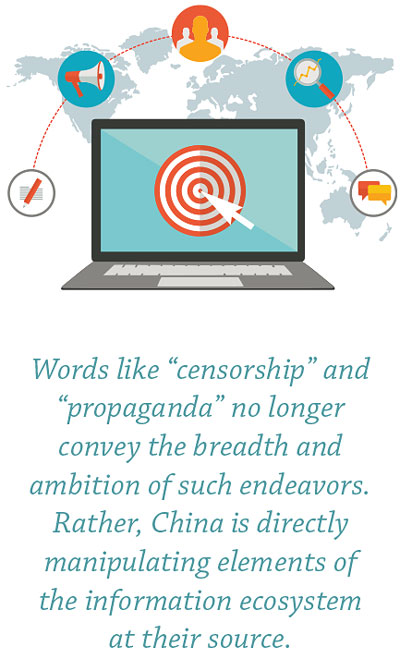 proponent of “Internet sovereignty,” which favors authoritarian tactics to control information. It has developed sophisticated cyber capabilities, and has promoted the interests of its largest Internet companies overseas, known loosely as “Internet Power.” This approach is likely to undermine trust in the global Internet and limit the free flow of information worldwide.
proponent of “Internet sovereignty,” which favors authoritarian tactics to control information. It has developed sophisticated cyber capabilities, and has promoted the interests of its largest Internet companies overseas, known loosely as “Internet Power.” This approach is likely to undermine trust in the global Internet and limit the free flow of information worldwide.
3. Global culture and opinion, most significantly through Hollywood. Although China is engaged in a number of efforts to boost its cultural soft power, such as through sports, festivals, cultural and language institutes, and other venues, its engagement with Hollywood has the largest potential reach. Because China is an increasingly important market for the global film industry, entertainment firms have been striking deals that help give them access to that market, but put them at the mercy of Chinese censors. This leads to content either edited to fit the Chinese market, or proactively shaped to exclude anything the Chinese government might consider sensitive in the first place. Chinese co-productions are also more likely to feature positive depictions of China.
What emerges is an altered understanding of the ways in which authoritarian regimes like China can wield power in the global information arena. Words like “censorship” and “propaganda” no longer convey the breadth and ambition of such endeavors. Rather, China is directly manipulating elements of the information ecosystem at their source, whether in the conceptual stage of Hollywood films or at the editorial level of news reporting. The CCP has long used multiple methods—including leverage of the private sector—to proactively harness information resources within China’s borders. Increasingly, those methods are being used to amplify China’s power beyond them.
Context: Managing Internally, Projecting Externally
History of Controlling Information Resources
Much of the current discourse on China’s information-shaping capabilities revolves around how it largely contains the political impact of information vis-à-vis challenges to the ruling Communist Party. In the late 1990s and early 2000s, when optimism surrounding technology companies surged and the spread of communication technology in particular seemed inextricably linked to the spread of freedom, it seemed inconceivable that Beijing could ever hope to manage the political impact of information, particularly conveyed through what was then viewed as the unstoppable force of the Internet. Indeed, the dominant metaphors of the time—putting the “genie back in the bottle”—prevented serious consideration of how authoritarian states might still be able to control information in a digital environment.3
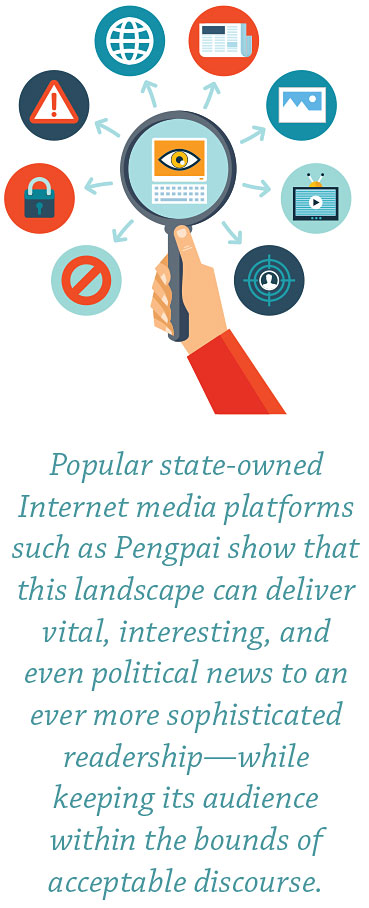 In truth, control of information has been central to the Party’s strategy since it first came to power. Persuasion and information management have always been top priorities, worthy of extensive bureaucratic and financial resources.4 Under Mao, for instance, the media served the state through reinforcing ideological hegemony, while telecommunications were centralized under a powerful ministry. Since the Internet began to spread within China, the state has maintained control of both infrastructure and content. Notably, it has done so through cooperation with (or cooptation of) the private sector, allowing enough freedom to innovate and capture market share while ensuring that political discourse does not prove destabilizing. 5
In truth, control of information has been central to the Party’s strategy since it first came to power. Persuasion and information management have always been top priorities, worthy of extensive bureaucratic and financial resources.4 Under Mao, for instance, the media served the state through reinforcing ideological hegemony, while telecommunications were centralized under a powerful ministry. Since the Internet began to spread within China, the state has maintained control of both infrastructure and content. Notably, it has done so through cooperation with (or cooptation of) the private sector, allowing enough freedom to innovate and capture market share while ensuring that political discourse does not prove destabilizing. 5
This does not mean that any and all politically sensitive discourse is automatically censored or redirected. Rather, censorship is localized (usually within the corporate platforms that deliver content), internalized (so that the public has a general sense of which topics are off limits), and distributed (within different bureaucracies and organizations), so that management and containment mechanisms are built into every feature of China’s information landscape, from Internet content to book publishing.6 Indeed, popular state-owned Internet media platforms such as Pengpai show that this landscape can deliver vital, interesting, and even political news to an ever more sophisticated readership—while keeping its audience within the bounds of acceptable discourse.7 These and other examples demonstrate that China’s current information management techniques, even domestically, do not fit neatly within the realm of “censorship” as traditionally defined.
Beyond Soft Power
Nearly all states seek to extend their influence through “soft power,” generally thought of as power through persuasion and attraction rather than power through military force. The United States, through its media, culture, economy, political system, and numerous other attributes, wields immense soft power. China, which is now the world’s second largest economy and boasts over 700 million Internet users as well as several of the world’s largest Internet companies by market value, has been significantly—and deliberately—expanding its soft power. Indeed, it has learned from watching the United States, and has, over the years, rolled out a strategy to significantly increase its soft power as a way to carefully position China as a formidable though nonthreatening global power.8 As soft power scholar Craig Hayden notes, “China represents the most comprehensive utilization of resources to cultivate soft power by an international actor other than the United States.”9
This soft power strategy, championed perhaps most loudly under former president Hu Jintao, continues today. Previous five-year plans have included a “going global” strategy of cultural promotion, emphasizing the need to “form public opinion powers commensurate with China’s international status.”10 More importantly, perhaps, the strategy features buy-in from China’s leading entrepreneurs. In a Q&A at the time of his purchase of the leading English-language Hong Kong newspaper, the South China Morning Post, Jack Ma, the head of Chinese Internet giant Alibaba, also emphasized the need for China to build its soft power: “For eight centuries or more, China was a world-leading civilization with the largest gross domestic product. Because of our isolation policy, we fell behind. China opened up again over the last three to four decades, trying to change its system and embrace the world. The country has made great strides in growing its soft power and cultural influence.”11
While a component of China’s soft power strategy has long been straightforward propaganda, or “thought work” as it has traditionally been known, this official line has now been overshadowed by a wide variety of more sophisticated media, communication and culture elements. More importantly, there is a strong component of marketbased allure and logic implicit within China’s long-term soft power strategy. (As some scholars note, soft power is based on perception and inferences; thus, the mere perception that China may form an important trading partner in the future may extend its influence in certain regions or sectors.12)
Certainly, Chinese leaders have recognized that market-driven communication elements can be far more effective than stateowned organs issuing stiff proclamations. With the Party setting overall guidelines, private companies and more market-oriented state institutions have, over the past several years, developed a degree of freedom to innovate and produce products that are in line with what global consumers of information and culture desire.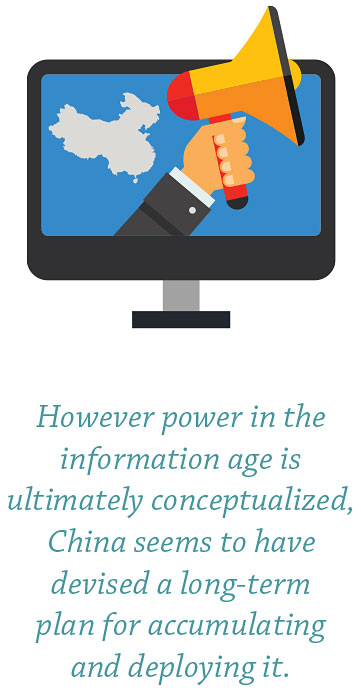
But to describe China’s marshaling of information resources as simply soft power does not go far enough. While not the primary focus of this paper, China has also deployed its cyber capabilities quite effectively as hard-power tools. The idea of “smart power,” a combination of both hard and soft power, might get closer to Beijing’s execution of its information strategy.13 Essentially, China understands the idea that power is comprehensive, integrative, and multidimensional—what China scholar David Shambaugh calls “comprehensive power.”14 Shambaugh has examined China’s efforts in several spheres, including perceptual, diplomatic, global governance, economic, cultural, and security.15 Notably, the global information ecosystem both undergirds and amplifies many of these spheres. However power in the information age is ultimately conceptualized, China seems to have devised a long-term plan for accumulating and deploying it.
Despite fluctuations in emphasis, this overarching framework has continued throughout the last several iterations of Chinese leadership, and does so even now, at a time when domestic Chinese media and civil society are under more severe constraints than they have been in the recent past. President Xi Jinping has assertively moved to centralize and consolidate his power, partly through a tighter crackdown on dissent, targeting civil society and the media in particular.16 The Party’s own propaganda department has not escaped scrutiny: after a two-month investigation into propaganda operations, in September 2016 the Central Commission for Discipline Inspection criticized the department for its news operations (which were found to be not targeted or effective) and for insufficient leadership in ideological work.17 At the same time, Xi has also explicitly endorsed the long-term approach: he has elevated concepts such as Internet sovereignty, and has said he wants Chinese media to “tell China’s story” to the world, a sentiment echoed by prominent Chinese entrepreneurs like Jack Ma.18
Shaping International News: A Multi-Pronged Approach
China has long restricted its own journalists from reporting freely on news within the country. While it has focused in the past on monitoring foreign news correspondents within China, it has more recently beefed up its proactive efforts to shape international media coverage of China and the issues it considers vital to its national interests. It has also worked closely with news organizations in some developing countries, particularly in Africa, to instill its own brand of journalism values. Here, we look at how China seeks to influence international news in three main ways: influencing foreign reporting on China; promulgating its own viewpoint internationally through its international broadcasting and publication arms; and influencing the structure of news organizations through training and cooperation.
Foreign Reporting: Pressures at the Source
China has always monitored and at times harassed foreign reporters operating within its borders. Under Xi Jinping, this practice has expanded. A recent PEN America report asserts that foreign journalists in China now face more restrictions than at any other time in recent history (although opinions vary on how severely working conditions for foreign journalists have deteriorated compared to past years).19 PEN’s report also points out that Xi’s campaign to stifle dissent has made sources more reluctant to speak with foreign journalists, and that Chinese officials perceive foreign media as biased against China.20
Partly because of these sensitivities and perceptions of bias, the government has widened its focus from monitoring foreign journalists to broadly influencing international reporting on China (or issues that China considers vital to its security). As former minister of the Information Office of the State Council Zhao Qizhang has said, “It is especially important for us to give high priority to offering explanations to the international community about matters such as the human rights issue, the Tibetan and Taiwanese questions, the issue of religion, the Falun Gong cult question, and the theory of a ‘China threat.’”21
Hence, Beijing seeks to influence international reporting through a combination of direct action, economic pressure to induce self-censorship by media owners, indirect pressure applied via proxies such as advertisers, and cyberattacks and physical assaults.22 Moreover, China uses its own system of domestic censorship as a coercion tactic, by threatening to block access to foreign news websites as a form of retaliation.
Two prominent examples from the recent past illustrate some of these measures. In 2012, the Chinese government blocked the entire websites (as opposed to single pages) of both the New York Times and Bloomberg in China as a consequence of those organizations reporting on financial holdings of relatives of current president Xi Jinping and former premier Wen Jiabao. As a report by Sarah Cook notes, the blocking of the Times’ newly launched Chinese website resulted in financial losses for the Times, while the website blocking plus intimidation measures (such as tailing employees) seem to have deterred some of Bloomberg’s potential business partners. Both media outlets were also subject to strong pre-publication pressure from the Chinese government, while Bloomberg reportedly chose not to release an accompanying video segment to the Xi Jinping article after the Chinese government expressed displeasure.23 Although it is unclear to what degree the Chinese government’s overall efforts to influence coverage in this way have succeeded, the PEN report points out that Beijing has successfully exploited the division between international media organizations’ (typically firewalled) business and news-gathering divisions, capitalizing on companies’ desire to continue to do business in China.24
Beijing also pressures foreign media operating outside of China entirely. Since Xi came to power in November 2012, Freedom House estimates that China has negatively affected freedom of expression outside China over 40 times in 17 different countries and institutions.25 Beijing has particularly targeted overseas Chinese language media, focusing on neutralizing antagonism, increasing antipathy toward anti-government forces, and encouraging investment.26 After publishing a column critical of Chinese diplomat Wang Yi, a prominent columnist for the Global Chinese Press (a Canadian Chinese language outlet) was told that his column was being dropped because “some people don’t want to see your name in the paper.”27 China has also extended its influence over the formerly lively Australian Chinese language media space. As one analyst wrote, “topics on which press discussion is forbidden in China have vanished also from the Chinese language media in our own country,” with two large pro-China media groups now controlling much of the Chinese language media there.28
Hong Kong Chinese language and English language media—meant to be free from political influence after the 1997 handover of the territory from the United Kingdom to China—have long been seen as a test case. The Hong Kong media sector has been under pressure to toe the line in recent years, with many experts noticing a rise in self-censorship or less critical discourse on politically sensitive issues. The Hong Kong Journalists’ Association issued a warning in 2016 that Hong Kong autonomy was “seriously threatened by a spillover to Hong Kong of Chinese ideological control.”29 Cook and others note that influential Hong Kong newspapers have been bought by businesses with interests in China or close ties to mainland officials, resulting in, for instance, toning down critical rhetoric and prioritizing soft news over investigative journalism.30
In December 2015, the English-language South China Morning Post (SCMP) was bought by Jack Ma, the founder and executive chairman of AliBaba Group, China’s (and the world’s) largest e-commerce conglomerate. At the time, Ma promised that Alibaba’s management would not be involved in the SCMP’s newsroom operations, and that “the paper’s China coverage should be objective, reasonable and impartial.”31 However, since then, media analysts have raised questions about the paper’s continuing independence, a concern that was highlighted during an incident in which the SCMP somehow gained access to just-released, formerly imprisoned Chinese legal activist Zhao Wei, obtaining a self-denunciation of her former activities, before even her husband and lawyer had been able to contact her.32 This was not the only such incident: a month later, prominent Chinese human rights lawyer Wang Yu, who had been similarly detained, re-emerged in an interview affiliated with Hong Kong newspaper Oriental Daily, renouncing her legal work and accusing foreign forces of attempting to smear the Chinese government. While such “confessions” by activists denouncing their former activities are not uncommon in Chinese state media, it was unusual to see Hong Kong media organizations play such a prominent role.33
Chinese Media: Projecting Ambitiously if not Seamlessly
But pressuring foreign news outlets is only one piece of the puzzle. Broadly, Party propaganda seeks to cultivate the image of China’s benevolence, as a civilization and international partner.34 China scholar Andrew Nathan notes that an important secondary theme of such propaganda is “the upholding of the Chinese style of rule, via polemics touting the benefits of Chinese-style socialism, identifying CCP rule with traditional Confucian values like social harmony, and explaining the suitability of China’s political system to China’s ‘national conditions’ (guoqing).”35
Thus, Beijing has also focused on amplifying China’s own voice in the global media landscape. In doing so, it has relied on “borrowing foreign newspapers,” (jieyong haiwai baokan), which has expanded from cultivating relationships with foreign journalists thought to be sympathetic to China, to placing stories directly within foreign media, often through supplements.36 Beyond outlets owned outright by the Chinese government, it can also count on the cooperation of Chinese media investors who share interests with Beijing. According to Reporters Without Borders, this fits with a worldwide trend of oligarchs—usually with friendly, and sometimes official, ties to their authoritarian governments— buying up media outlets to enrich their business interests and further curry political favor by slanting coverage in favor of the government.37
China’s propaganda strategies have now evolved in an attempt to keep up with the times. Previously stodgy and peppered with official-sounding language, overseas propaganda began to transform in the 1990s: the Overseas Propaganda Department was renamed the “External Publicity Department” (a semantic, but telling, change). New institutions were “charged with ‘publicizing China in an authentic, colorful, lively, and timely way’ to effectively deal with growing fears of China’s rise in power in the 1990s,” writes Hayden.38 Propaganda operations have now been consolidated within the State Council Information Office.39
In the early 2000s, the Party began to more directly focus on creating globally competitive Chinese media organizations, through a program of zuoqiang zuoda (“Making media big and strong”), intended to create competitive global media organizations.40 Beyond simply seeking to reach a global audience, Beijing also sought to target specific audiences relevant to its foreign policy concerns (such as in its establishment in 2008 of a television channel for the countries of the Commonwealth of Independent States).41 According to Hayden, China spent nearly $9 billion for international broadcasting and publicity in 2009–2010, with most of this going to China Radio International (CRI), China Central Television (CCTV), the official Xinhua news agency, and the Englishlanguage China Daily newspaper. Brady points out that many available figures include only subsidies to media targeting foreigners, so the entire amount may be significantly larger.42
These efforts vary in the extent to which they seamlessly blend into the global media landscape. The English language China Daily for the US market, for instance, has opted to place paid supplements, called “China Watch,” in mainstream US newspapers like the Washington Post. China Watch itself contains a fairly standard mix of sanitized content designed to reflect official Chinese positions and extoll the cultural virtues of China, unlikely to be confused, except by the most casual reader, with genuine reporting by the Washington Post (recent headlines included “Belt and Road ‘beyond expectations’”—referring to China’s ambitious Central Asian economic development initiative—and “Foreign Eyes Offer New View of the Long March”).43
Yet, although the physical inserts in the Washington Post are clearly marked as advertising supplements that do not involve the editorial department of the newspaper, some have argued that the online versions might easily be mistaken for special reporting or blogging by Washington Post staff on China, as the URL is nested within the “real” Washington Post site (the current online version of China Watch can be found at http://chinawatch.washingtonpost.com/).44 China Daily inserts are also available in Europe, Asia, and Africa.45 When the paper signed MOUs to enter the Australian market this year, it raised general worries about Chinese influence in both English language and Chinese language media,46 signifying that its efforts to not appear as propaganda may have been unsuccessful.
The expansion and professionalization of CCTV has garnered more widespread praise and acceptance globally. At the end of 2016, CCTV rebranded its international broadcasting and digital operations as China Global Television Network (CGTN), consolidating global operations and launching new mobile apps in various languages. Henceforth, all foreign language channels, digital and video content will fall under the new group, as part of a plan to adapt to media convergence.47
CCTV has significantly expanded China’s global broadcasting footprint, opening major global offices in Beijing, Washington and Nairobi, and dozens of international bureaus, during a time when many media outlets worldwide are retrenching and scaling back on coverage of foreign news. Analyst Anne Nelson notes that CCTV now produces sophisticated longform reports on complex international issues such as climate change, hires world-class international journalists, and encourages independent reporting—as long as such reporting does not cross Party red lines.48 In this, CCTV appears to be explicitly modeling itself after Al Jazeera, which has gained a reputation for independence and credibility in the Middle East while being careful not to offend the sensibilities of its backer, the government of Qatar. Because of this, it is unlikely that norms of independent journalism are likely to become established as part of CCTV’s domestic coverage. Moreover, in countries in Africa, where CCTV has long had a presence, it is increasingly not viewed as propaganda, but as journalism with a “constructive” focus.49
That said, the example of China Radio International (CRI), China’s state-owned international network of radio broadcasters, points to the opportunities and challenges inherent in the ambitious global expansion of Chinese state media. China Radio International’s global ambitions have not exactly been hidden, particularly after the creation of the China International Broadcasting Network, and establishment of transmission capabilities in the United States, Europe, the Middle East, and Africa.50
Yet a Reuters investigation in 2015 sparked an FCC investigation, when Reuters reported that CRI’s local US partners were three Chinese expatriate businessmen who ran the international network and in some cases owned stakes in the stations. US and Chinese corporate records showed that a Beijing-based subsidiary of CRI owned 60 percent of an American company leasing almost all the station’s airtime (US law prohibits foreign governments or their representatives from holding radio licenses for US broadcast stations).51
State-owned media’s attempts at utilizing social media and memes to appeal to a global, information-saturated audience have met with mixed success. On one hand, even conservative state organs like the People’s Daily are experimenting with clickbait, as evidenced by such headlines as “Chairman Xi Discussed These Eight Things With Americans. We Should Definitely Listen.”52 But the English-language Twitter feeds of Xinhua and China Daily, explicitly designed for consumption by foreign audiences, remain somewhat clunky and propagandistic in their look and feel, qualities anathema to acceptance by a global public on social media more used to ironic, snappy wit.
Changing The Fundamentals: Shaping Communication in Developing Countries
Like other countries, China is involved in supporting the media and communication sectors of developing countries, providing resources and training. Unlike most other international donors in this space, however, China does not support the typical goals of such assistance, such as freedom of expression, editorial independence, neutral protocols, and the capacity of journalists to hold the government or other powerful actors to account.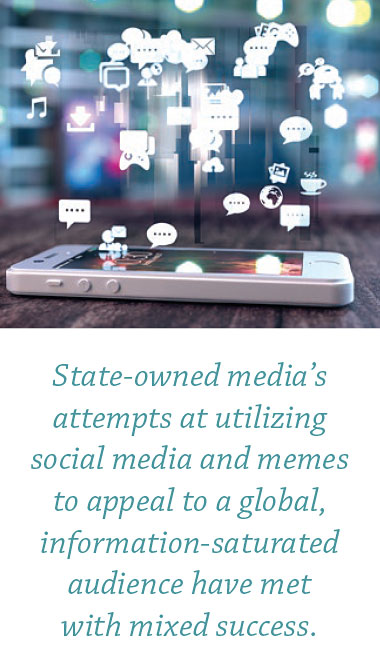
Instead, as Douglas Farah and Andy Mosher point out, China’s primary purpose is to ensure a China-friendly media and communication sector in these countries, one that will portray China as a reliable partner. Ideally, this media sector will also support China’s policy positions on everything from opposing US policies to isolating Taiwan.53 In turn, this forms part of Beijing’s larger aim to “fundamentally reshape much of the world’s media in its own image, away from a watchdog stance toward the government to one where the government’s interests are the paramount concern in deciding what to disseminate,” according to Farah and Mosher.54 This also helps authoritarian governments maintain or expand control of local media. Despite China’s stated interest in not promoting its own system of government, its policies in this arena are indeed helping to do just that.
For its part, China maintains that it is simply engaging in the same type of diplomatic engagement and influence practiced by any number of Western countries. Certainly, many Western industrialized democracies seek to foster independent media sectors in developing countries in an effort to support more democratic governance. But where the development assistance community’s independent media development model would allow for journalism critical of the national government or the supporting donor’s policies, China’s model allows little room for independent criticism, and explicitly seeks to present a positive view of China. Indeed, China seeks to foster a different kind of journalism altogether, which it dubs “constructive journalism.”55 In this model, journalism should seek to emphasize solutions and de-emphasize bad news about national governments—and China.
Apart from prominently positioning its own state-owned media in local countries, China relies on a variety of methods for helping to develop the media and communication sectors of developing countries. These include provision of direct government aid to local state-run media, for the purchase of radio transmitters and national satellites; provision of content and new technology; memorandums of understanding on news sharing (particularly in Southeast Asia); and training programs and expense-paid trips to China for journalists.56
This approach has been the subject of much discussion in Africa, where China has long fostered diplomatic relations. The Forum on China-Africa Cooperation (FOCAC), whose fifth meeting in December 2015 was attended by Xi Jinping and other heads of state, cemented the continent’s continuing diplomatic importance to China. FOCAC action plans from the current and previous periods contain specific references to China’s active media programs on the continent, including the China-Africa Press Exchange Center Program’s continuing training and exchanges, China’s provision of training for 1000 African media practitioners per year, support for radio and TV digitalization, a role for Chinese company StarTimes in migrating analogue to digital television, cooperation in film and TV production, and the institutionalization of the Forum on China-Africa Media Cooperation as an official subforum of FOCAC.57
China’s funding to various countries’ media and communication sectors is vast and can take many forms, not all of them easily categorized as political. Yet the net effect of such funding is to support either the state or China’s priorities, or both. In Ethiopia, for instance, Chinese telecommunications giant ZTE helped fund the expansion of Ethiopia’s homegrown WoredaNet, a state-oriented intranet. Rather than allowing individuals to independently seek and receive information, however, WoredaNet prioritizes communication between central government officials and local districts.58 In Zambia, China provided significant support to ostensible public service broadcaster Zambia National Broadcasting Corporation (ZNBC), helping to extend ZNBC’s FM signal across the country. Yet independent analysis of ZNBC’s coverage found clear bias for the ruling party in its coverage.59
Arguments regarding the Chinese media and communications presence in Africa frequently focus on China’s state-owned platforms and their evolution from straightforward propaganda organs to news organizations that are not afraid to present some hard-hitting issues. Yet the more interesting effect of Chinese state-owned media in Africa is in their long-term promotion of China’s “constructive journalism” model, which encourages some degree of self-censorship and generally frames the activities of the Chinese and national governments in a positive light.60
In Its Own Image: A Chinese-Influenced Global Internet
As noted, China has long managed information within its borders, and has generally managed the Internet’s impact domestically. But its approach has turned outward in recent years, focusing now on influencing the institutions that govern the Internet, the norms that guide its use, and the infrastructure and corporations powering its platforms.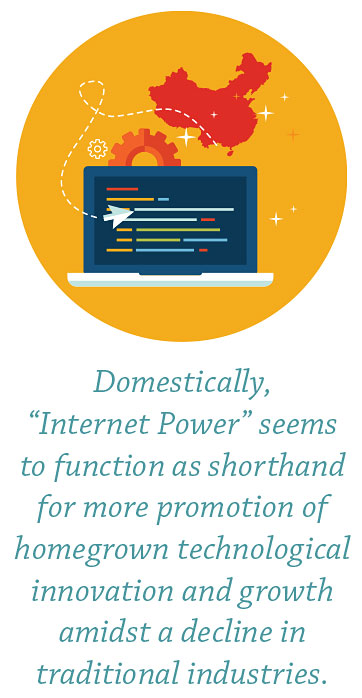
Such an approach is contained within a concept known in English as “Internet Power” (wangluo qiangguo, which translates directly into “Internet strong country”), promoted as part of the run-up to China’s 13th Five Year Plan (2016–2020). While not explicitly defined, official publications describe it as stepping up efforts to “encourage technological innovation, build a healthy cyber culture, strengthen infrastructure and cyber security, increase the use of information technology, and expand international cooperation.”61 Generally, the term is seen as encompassing four major themes: cybersecurity, economic development, soft-power, and cyber-sovereignty.62
Domestically, “Internet Power” seems to function as shorthand for more promotion of homegrown technological innovation and growth amidst a decline in traditional industries. On the international level, though, it appears to manifest itself in China’s actions in two key ways: 1) through advocating for an Internet subject to national sovereignty, an approach which also merges cybersecurity with policies of domestic censorship; and 2) through actively promoting a more active global presence for Chinese Internet companies.
Internet Sovereignty— A Theoretical and Practical Concept
In seeking to affect the international institutions, regulations and norms governing the global Internet, China’s approach is relatively consistent with its historic trajectory in issues of global governance. China scholar Shambaugh argues that since 2008 Beijing has sought to “selectively alter rules, actors, and the ‘balance of influence’ largely from within existing institutions—while simultaneously trying to establish alternative institutions and norms of global governance” within the international system.63
With respect to Internet governance, China is indeed seeking to do just that: work within existing institutions, such the United Nations, and utilize existing concepts, such as multilateralism. In doing so, it hopes to alter the locus of Internet governance, or perhaps more importantly, to get other countries to buy into alternative norms regarding how the Internet is conceptualized and governed. China, along with Russia, has championed the concept of Internet, or cyber, sovereignty, which embraces the right of countries to assert their own national control over the Internet. Such a concept would contribute to the fragmentation of the global Internet, and, in its framing by authoritarian regimes, conflates concepts of cybersecurity with stifling domestic protest.64
FRAMING INTERNET SOVEREIGNTY
The idea of national sovereignty in communications is not necessarily new. As communications scholars point out, for centuries governments crafted policies and regimes to promote sovereign control over their portions of cross-border information flows.65 The advent of the Internet proved different, however. Nearly since inception, the Internet has been governed in an almost ad hoc fashion by a variety of actors, including civil society, technical bodies and private companies, who have acted as network operators, information intermediaries and technical experts. As a result, states have largely been uninvolved, with Internet governance decisions being driven by technical or market considerations.66
China has sought to use prior history of state involvement in global communications to support its own position regarding what the Internet should evolve to look like. Over the past few years, China has been reinforcing its conception of Internet sovereignty, which calls for a government-centric regulatory approach to the Internet, with national governments determining the content and structure of the Internet within their borders (unsurprisingly, this describes China’s current approach). In an op-ed entitled “Cyber Sovereignty Must Rule Global Internet,” the former director of China’s Cyberspace Administration, Lu Wei, emphasized the need for mutual understanding on such issues between the United States and China, highlighting the difference between the US position advocating multistakeholder governance.67
The distinction seems minor, but it is important. The United States and its allies favor the multistakeholder model of governance because, in its ideal form, it involves a bottom-up process that incorporates civil society (including technical experts, NGOs, and users), government, and the private sector. Civil society actors have sought to make the process transparent and participatory, with events such as the Internet Governance Forum designed explicitly to highlight current issues and seek collaborative solutions. The process is meant to correspond to the global Internet’s decentralized and nonhierarchical structure, which was originally conceptualized as immune to control by any single government.68
China and other authoritarian countries advocate a multilateral process because it inherently privileges the position of states, thus putting the responsibility for governance at the feet of state-based institutions such as the United Nations and the International Telecommunication Union (ITU). (For the first time in history, the current head of the ITU is also a Chinese national, who some say favors greater government involvement in the development of the Internet.69) The latter approach also finds supporters within some developing countries who may lack the private sector and civil society capacity to influence the multistakeholder process and thus feel they may carry more weight in a state-centered multilateral process.70
Developing countries may also be sympathetic to some of China’s arguments regarding US corporate influence over the Internet. In his remarks at a recent “Safe Internet Forum” organized by China and Russia, the man credited as the architect of the Great Firewall, Fan Binxing, argued that since American hosting companies control the Internet (and since these companies are controlled by the US government), the Internet was already under US sovereignty, so the only question was whether such sovereignty would be shared.71 Global distrust of US government motives, fueled by the surveillance revelations of Edward Snowden, has helped contribute to skepticism over US support of the current, multistakeholder model. That said, developing countries were instrumental in creating and putting into effect the Global Multistakeholder Meeting on the Future of Internet Governance (the NETMundial initiative), which some called a rebuttal of the idea of Internet sovereignty.72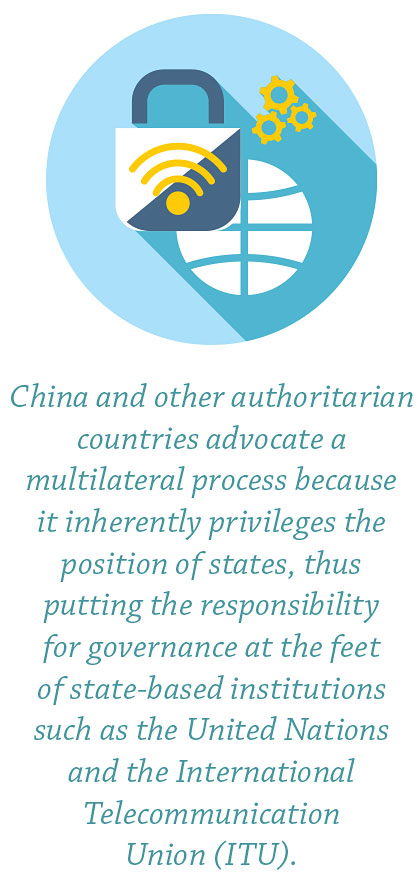
ACTIONS IN INTERNATIONAL ARENAS
China has streamlined its bureaucracy to better elevate Internet policy and consolidate domestic and international interests. In 2013, under president Xi Jinping, the CCP created a Central Leading Group for Cybersecurity and Informatization, meant to develop broad Internet policy. The State Internet Information Office was elevated to become the Cyberspace Administration of China (CAC), in charge of regulating online content.73 (The CAC’s former powerful head, Lu Wei, was instrumental in recent years in promoting China’s domestic Internet clampdown and conception of Internet sovereignty;74 his successor, Xu Lin, thought to be closer to Xi Jinping, has imposed tightened controls over the Internet since his accession.)75
In recent years, China has acted ever more boldly in international forums to bolster its point about Internet sovereignty and recruit potential allies. At the 2012 World Conference on Information Technology (WCIT), the United States argued that the Internet was outside the mandate of the ITU and that aspects of its governance did not belong in rewritten International Telecommunication Regulations (ITRs), a 1980s treaty designed to foster global interconnection and interoperability.76 Yet China mobilized its allies to counter this position, and in the end eighty-nine countries signed the rewritten ITRs while only fifty-five countries (including the United States) rejected them. (The ITRs only bind states that sign the treaty.)77
But China experienced only mixed success in pressing its agenda during the Ten-Year Review of the World Summit on the Information Society, which produced a non-binding outcome document at the end of 2015. While Beijing did succeed in securing inclusion of the word “multilateral,” Beijing failed to get some of its other proposed changes (such as deleting “freedom of expression and “democratic”) into the document, and the document on the whole was supportive of the multistakeholder model of governance endorsed by the United States and is allies.78 (Earlier, China refused to endorse 2014’s NetMundial summit resolution due to its failure to include the word multilateral in the final document.)79
To seize momentum and assert its own agenda, China organized its own international conference, the World Internet Conference in Wuzhen. The purpose of Wuzhen is simple, argue some: “to promote the Chinese Communist Party’s vision of Internet governance to an international audience and to gain allies against the perceived Western encroachment upon China’s cyber sovereignty.”80 In its inaugural year, the conference was marred by bizarre and heavy-handed maneuvering: for instance, on the last evening, a draft declaration was slipped under participants’ doors in an effort to rush through last-minute approval of what was intended to be a consensus document.81 But the following year not only ran more smoothly, but featured high profile head of state attendance, including an in-person address by president Xi Jinping on the importance of respecting cyber sovereignty and rethinking the multistakeholder model. China continues to court Silicon Valley at these and other, private events.82
The emphasis on sovereignty extends beyond the current popular conception of the Internet, which is still viewed primarily as a peopleto-people communications platform, and is likely to encompass future iterations, such as the so-called “Internet of Things,” or the proposed connectivity of everyday objects, allowing them to send and receive data. For instance, in the lead-up to the World Telecommunication Standardization Assembly (WTSA) in October 2016, China advocated for a system called Digital Object Architecture, which could enable real-time surveillance of devices and individuals, to be the mandatory addressing system for the Internet of Things, and put under the mandate of the ITU.83 While DOA was ultimately sidetracked at the WTSA, China has signaled its intentions with respect to the emerging Internet of Things.
China is likely to continue its campaign to influence Internet norms and standards internationally in a variety of international arenas. That said, it has already implemented the concept of Internet sovereignty domestically—in essence, changing the facts on the ground until, as one expert puts it, “it will just present people with a fait accompli.”84
CYBERSECURITY AND SOVEREIGNTY
China has also wrapped cybersecurity (or “information security”) issues into its definition of Internet sovereignty. For China, international cybersecurity issues, offensive cyber capabilities, and domestic censorship are all closely linked conceptually. Beijing considers both offensive and defensive cyber capabilities key to national security, just as it considers certain content—domestic criticism and mobilization against the government—a threat to national security. For instance, in April 2016, China and Russia co-sponsored the “Safe Internet Forum,” featuring officials from both countries: panels included “Cyber Security: Security of Internet communications and governance of infrastructures,” “Countering the new religious movements in the Web,” and “Defending Value and Meaning: Quality of Internet Content.”85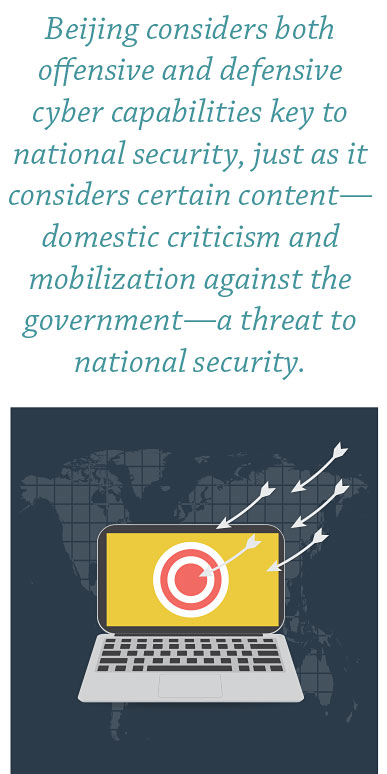
China’s international efforts in the “cyber” realm (in quotes to denote that such terminology usually refers to military and military-related deployment of information and technological capabilities) are simply too large to be discussed within the scope of this paper. But it is worth noting that China’s offensive capabilities—what Ron Diebert calls “third generation controls”—are, among authoritarian countries, the most advanced.86 These offensive capabilities are deployed internationally against a wide range of actors, with human rights, pro-democracy and independence movements outside China suffering the same digital attacks as foreign governments and Fortune 500 companies. A new attack tool, “The Great Cannon,” can even redirect website requests of foreign users into denial-of-service attacks, or launch malicious software.87
In framing domestic and international speech, assembly, surveillance and privacy issues as issues of cybersecurity, China hopes to situate the international discussion of cybersecurity principles within a conceptual framework of Internet sovereignty. Doing so would allow it to use cybersecurity to justify internal crackdowns: for instance, 2015’s anti-terrorism law required companies to assist terrorist investigations by providing “technical interfaces,” “technical means of support,” and encryption keys for any data located on private computer servers.88 Other Chinese cybersecurity rules require technology companies doing business with banks to demonstrate that their products are secure by making source code available to the Chinese government, providing the government with hardware and software backdoors, and localizing foreign intellectual property in China. The United States and its allies argue that such regulations are inconsistent with international cybersecurity best practices and may constitute trade barriers.89
Here, again, the choice of terms is significant. While “cybersecurity” tends to be used within policy circles in the United States, China and Russia have traditionally preferred the term “information security,” which means something very different than its usage in Silicon Valley to refer to basic principles of network security. China and Russia have called for a code of conduct for “information security”, requiring international cooperation to curb “the dissemination of information that incites terrorism, secessionism or extremism or that undermines other countries’ political, economic and social stability, as well as their spiritual and cultural environment”—i.e., restricting content that is thought to undermine stability.90 While such efforts have not yet met with success, it is the concept that is key—the idea that cybersecurity includes restrictions on political organizing, political speech, and other activities generally protected under international human rights covenants.
Internet Power— China’s Tech Companies Going Global
Amidst all its rhetorical posturing and international maneuvering, China understands a simple fact: its homegrown companies represent the most successful case for the Chinese Internet. China leads the world in e-commerce, accounting for 40 percent of global sales, and has four of the top 10 Internet companies in the world by market capitalization (including the aforementioned Alibaba and Tencent).91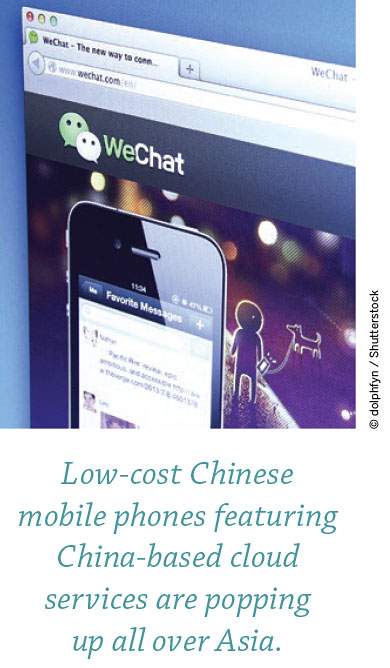
Thus, China’s “Internet Power” strategy, promoted in last year’s Five Year Plan, embraces this success. Five Year Plans in China are no longer regarded as gospel, but still constitute a significant way for the Party to signal its priorities to China’s vast array of local banks, officials, companies, and others seek the approval and favor of the central authorities.92 Inherent in China’s newest Five Year Plan is an emphasis on innovation, and in positioning China at the forefront of the global information economy. This Plan marks the first in which Internet businesses (including mobile) form an integral part of the strategy. “Currently, China’s economy has entered the “new normal” phase, where Internet-based new industries enter the spotlight and form a sustained driving force within the 13th Five-Year Plan period (2016– 2020),” notes one official publication.93
“Internet Power” sits at the heart of this strategy. Included in its emphasis on powering the innovation economy is the idea of “Internet Plus,” which incorporates big data and cloud computing into traditional enterprises in an attempt to make them competitive. Alongside a major upgrade of backbone infrastructure, the Internet Power strategy suggests a potent combination of state funding and incentives.94 It also suggests a more prominent role for China’s companies overseas.
This is a role they are already beginning to play. Low-cost Chinese mobile phones featuring China-based cloud services are popping up all over Asia. Chinese social networking apps such as WeChat and Sina Weibo started by imitating popular global platforms such as WhatsApp and Twitter (which are blocked in China), but have built on their censorship-driven market edge by innovating and producing new features.95
Chinese Internet giant Tencent’s WeChat is used by 100 million global mobile customers, counting among its users not only the global Chinese diaspora, but (somewhat surprisingly) the Tibetan exile diaspora. In an inversion of the usual metaphor, writes technology analyst Nathan Freitas, “instead of Chinese users scaling the wall to get out, people around the world are walking up to the front gate, knocking on the door, and asking to be let in.”96
Indeed, as companies spread overseas, they are bringing features of the Chinese Internet with them. As Freitas notes, all messages on WeChat are routed by Tencent’s centralized servers, located mainly in Shanghaibased data centers, and all subject to Chinese law, regulations, surveillance, and censorship. The app uses real phone numbers and SIM cards and is able to address users’ full address books and photos and copy all data to Tencent’s servers. Chinese citizens or not, all users of the service may potentially have their communications monitored and logged. And, like most apps, WeChat has permission to activate microphones and cameras and track location data, leaving users open to potential extraction of data and insertion of malware.97
This is not to imply that Chinese Internet companies have inherently malicious intent toward their customers; that would be poor business strategy, at the very least. But implicit within China’s current information economy is an understanding that state and corporate interests are cozily (and at times threateningly) entwined, and have been since the very beginning. Despite its willingness to champion its domestic Internet companies, Beijing doesn’t hesitate to exert authority when needed. Former CAC head Lu Wei, widely credited with reinvigorating the Chinese government’s control over the Internet, was well known for bringing China’s largest Internet companies into closer cooperation with Beijing.98
As China’s companies move overseas, they are likely to continue this overall pattern. In a way, this represents an inversion of China’s original strategy with respect to the Internet: in the beginning, it sought to coopt overseas Internet companies so that they either conformed to domestic censorship and surveillance rules or did not get market access. Now that Chinese Internet companies have benefited from the absence of foreign competition in the domestic market, they are ready to head overseas, having internalized China’s norms around Internet sovereignty, censorship and surveillance.
This is not likely to be uncomplicated for either the companies or the Chinese government. Global users—who in some cases may be accustomed to guarantees of privacy and safeguards against surveillance—are not as likely to be comfortable with having all their data potentially within the reach of the Chinese government. As cybersecurity analyst Tim Maurer notes, “this notion of technological sovereignty implies certain changes to the Internet at several layers—whether it’s physical infrastructure, applications or control of content—that will increase the cost of doing business globally through the Internet.”99 At some point, Beijing may have to choose between the continued global market success of Chinese companies and its emphasis on sovereignty (and all it implies).
Building Friendly Feelings: Hollywood
One thing that Beijing has learned from its propaganda efforts is that presentation of overtly political messages, even ones framed in as sophisticated a manner as possible, is rarely enough to truly change opinion. China has also seen America derive tremendous soft power from its culture and entertainment. As one Chinese communications scholar notes, “What good is communication if people won’t accept it? … that strict political approach will not win the people of the world over to a more positive view of China. Entertainment … without a strong political message won’t achieve an overnight effect. But over the long term it will build friendly feelings toward China.”100
In previous years, discussion of China’s soft power placed emphasis on the transmission of Chinese culture to the outside world. In the recent past, this emphasis has shifted, with the government committing to support Chinese investment in global entertainment. Wharton professor Z. John Zhang explains that “aside from being good business, it is a way to protect China’s influence in the world.”101 This blending of smart business with soft power explains why China’s involvement in Hollywood—one of the most dominant means of cultural transmission in the world—has proved such a potent mix in recent years. China has realized a powerful truth: that through Hollywood, in a form of marketbased judo, it can use the soft power strength of the United States for its own purposes.
While the entertainment and cultural element of soft power is an important part of the Chinese government’s discourse, its method for achieving this has been entirely market-based. With Hollywood blockbusters falling short in the domestic market but exploding in China, major studios have sought to appease Chinese censors in exchange for a foothold in China’s extremely limited release market. Meanwhile, Chinese firms are buying up big pieces of the US entertainment industry and entering into co-productions, changing the face of Hollywood moviemaking. The international film industry is in the process of a giant shift, one that will see China and the United States operating “as one symbiotic industry.”102
The Chinese Market: Important, but Difficult to Enter
There is no secret to why Hollywood is anxious to toe Beijing’s line: it’s all about the domestic market. The entertainment industry is booming in China, unlike other traditional industries. For the five years preceding 2016, it grew at a rate of 17 percent per year, and is thought to be worth $180 billion.103 McKinsey and Co. has predicted that 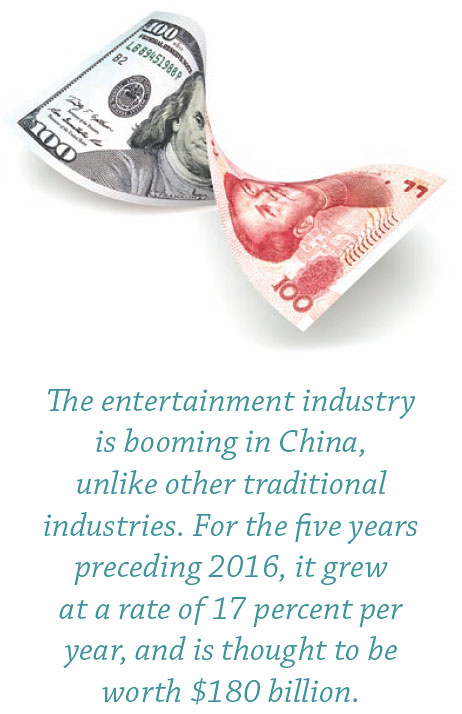 China’s film audience (with ticket sales second only to the United States) will exceed that of the United States in four years. China’s box office revenue hit $6.8 billion in 2015,104 and the country’s multiplexes are thought to be multiplying by a rate of twenty screens per day.105 Growth in 2016, however, slowed, with movie ticket revenue rising just 3.7 percent—a respectable number for mature markets but a significant drop for China. Even amidst the drop, however, imported international films (mostly from Hollywood) accounted for 41.7 percent of total box office in 2016, a rise from 38.4 percent the year before.106
China’s film audience (with ticket sales second only to the United States) will exceed that of the United States in four years. China’s box office revenue hit $6.8 billion in 2015,104 and the country’s multiplexes are thought to be multiplying by a rate of twenty screens per day.105 Growth in 2016, however, slowed, with movie ticket revenue rising just 3.7 percent—a respectable number for mature markets but a significant drop for China. Even amidst the drop, however, imported international films (mostly from Hollywood) accounted for 41.7 percent of total box office in 2016, a rise from 38.4 percent the year before.106
Indeed, Hollywood tentpoles—regardless of how well they do in the United States—continue to smash records in China. Fast and Furious 7 earned $63.1 million on its opening day in 2015, nearly doubling the previous record of Transformers 4: Age of Extinction, and took in more than $390 million in its run. Both films did better in China than in the United States, making the Chinese market at least as important as the US for these types of films.107 In fact, Pacific Rim 2 became the first Hollywood sequel to be approved due entirely to international (and significantly Chinese) audiences.108
But even given these impressive numbers, it is not easy for foreign companies to actually make money in China. Hollywood can only access the Chinese market in three ways: through revenue-sharing films (which allow foreign studios to take 25 percent of the box office, or half the norm for other parts of the world), flat-fee movies (which are unprofitable and therefore unpopular), and co-productions with a Chinese company (which do not count as foreign films, and allow foreign studios to receive 50 percent of total box office receipts).109 Quotas hammered out under the WTO restricted foreign revenue-sharing films to 20 per year before 2012, and 34 per year since then.110 The annual import quota and state monopoly on distribution of quota films will come up for discussion in February 2017,111 and if consultations fail to produce an agreement by January 1, 2018, the United States can pursue procedural action in the WTO.112
To be approved for distribution, movies must pass the Film Bureau, part of the State Administration of Press, Publication, Radio, Film and Television (SAPPRFT), which reports directly to the State Council and enforces censorship guidelines that ban, inter alia, content that harms China’s national honor, disrupts social stability, endangers the unity and sovereignty of China, or disparages the government and political figures.113 In addition, there are restrictions on depictions of sex, religion, superstition, and a host of other sensitive topics.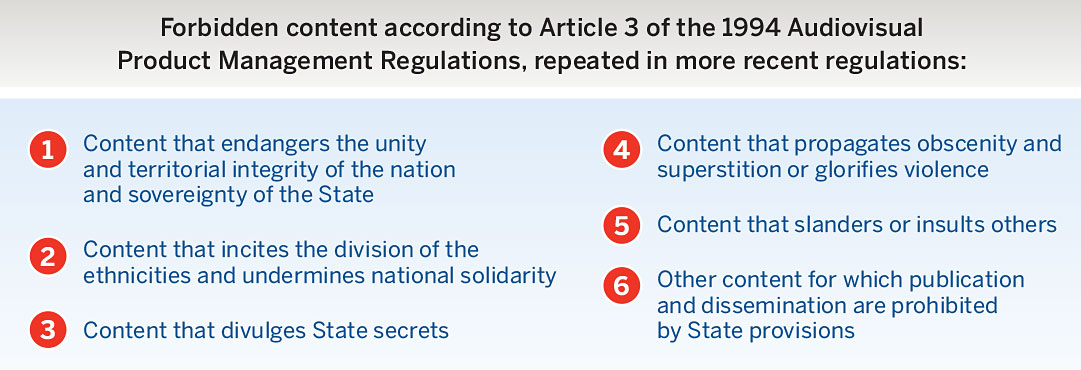
On top of the official regulations, there are somewhat hazy measures designed to ensure that domestic films gain at least 50 percent of the market, including reducing the number of 3D screens and releasing Hollywood blockbusters against each other to reduce the competition with domestic productions.114 Traditionally, foreign films are also restricted from showing during certain parts of the year, known colloquially as a “domestic movie protection period” because it gives local films less competition during summer school break and during Chinese New Year and other holidays.115 Last year, after a slow second quarter, the blackout periods appeared to be suspended over the summer—although without any official announcement.116 This lack of transparency is par for the course. As one executive described the lack of clarity regarding the summer film blackout season, “Nothing is absolute, clear-cut… it will always be subject to adjustments, revisions and interpretations.”117
Xi Jinping’s crackdown on media and civil society has permeated culture and entertainment as well. “Lately, members of the censorship board seem uncertain, fearful and overly careful,”118 wrote a Sony China executive in a leaked email from 2014. The fear of censorship—and attendant fear of not being allowed access to the China market—sits at the heart of the various strategies around co-production, acquisition, and content management discussed here.
Co-Productions: Getting Market Access
Given the difficulty of getting a film approved as part of the official quota, many studios are choosing the co-production route. Co-production has become popular because the Chinese studio can be directly involved in production, while foreign studios can take advantage of cheaper costs by filming there.119 However, while many films have collaborated with China by using some type of Chinese talent, financing or locations (including Looper, X-Men: Days of Future Past, Skyfall, Resident Evil: Retribution, and Iron Man 3), to be considered an official co-production (and thus not subject to the import quota), films are required to have at least one scene shot in China, cast at least one lead Chinese actor, receive a minimum one-third of total investment from Chinese companies, and illustrate “positive Chinese elements.”120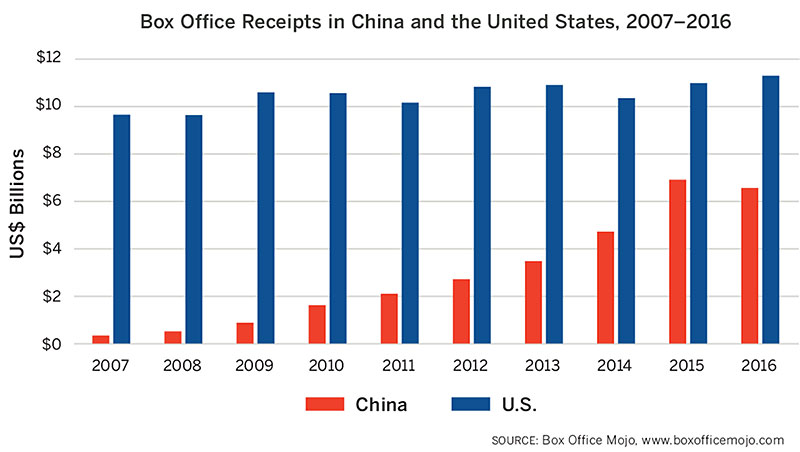
The recent example of Warcraft: The Beginning, has served as a sort of test case for the allure of coproduction (in this case, between Universal and Legendary, which was acquired by Chinese conglomerate Wanda Media Group).121 Intended to be a US summer blockbuster, Warcraft tanked with audiences and critics, opening at just $24 million (against a $160 million budget). But Warcraft opened in China to a five-day total of $156 million, the highest ever debut for a foreign movie.122 Analysts attribute its success to a specific strategy engineered toward China, with Legendary enlisting Chinese financial partners like Tencent and Huayi Brothers Media, crafting brand sponsorship deals and promotional partnerships along the way.123
Now those partners have embarked on the most prominent US–China co-production to date, the $150 million film The Great Wall, directed by famed director Zhang Yimou and starring Chinese stars alongside US stars such as Matt Damon. Partners include Legendary, Universal pictures, the state-owned China Film Group, and Le Vision Pictures.124 Great Wall is seen as the first attempt at a genuine homegrown, English language crossover;125 on its first day in China, it grossed a respectable if not overwhelming $24.3 million, and garnered mixed reviews online.126 And other major US entertainment firms are gearing up to enter the market as well: Walt Disney is readying a major push into China, entering a multi-year partnership with the state-owned Shanghai Media Group Pictures in 2014 to make Disney-branded films in China.127
Yet co-productions, while gaining access to the Chinese market, are hardly safe from the censors. They are subject to the same approval as all other domestic productions, and must abide by Chinese laws and “aim to promote China’s economic and cultural prosperity.”128
Acquisitions: Synergy on Both Sides
Even as co-productions have stepped up, so has the Chinese presence in the infrastructure of Hollywood itself. In the last two years, both state and private Chinese media and Internet firms have been on a buying spree, acquiring studios, talent agencies, and top human resources themselves. For these firms, it is a way to diversify their businesses and acquire expertise; for Hollywood studios and other entertainment companies, it is potentially another route into the China market.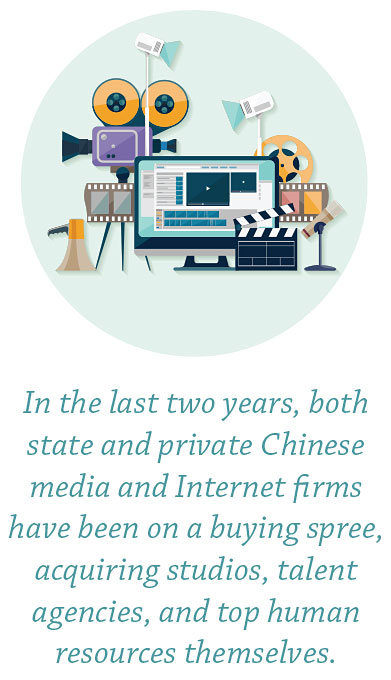
And the deals often cross the artificial boundaries separating Internet businesses from moviemaking and other forms of content production, creating the possibility for Chinese-owned, global, multimedia platforms. STX Entertainment, the studio behind the recent Free State of Jones and Bad Moms, announced earlier this year that it had secured financing to the tune of nearly $700 million in new capital from Chinese Internet giant Tencent Holdings (owner of China’s top social media platform, WeChat) and Hong Kong’s PCCW. (Existing investors included China’s Hony Capital and TPG Growth.)129 STX executives, drawn from traditional Hollywood studios, are aiming to bridge the gap between American and Chinese entertainment industries across multiple forms of media, including television, apps, video games, social media, and film.130
Other deals have been equally high profile. Tang Media Partners (backed by Tencent) recently purchased IM Global (a film financing and sales agency), Studio 8 (started by a former Warner Brothers executive) is being backed by Chinese conglomerate Fosun International, while Hunan Television and Broadcast has invested in Lions Gate Entertainment (behind The Hunger Games and Mad Men).131 Tencent has also joined with Sequoia Capital China to form a joint venture with well-known Hollywood agency William Morris Endeavor (WME_IMG).132 The latter joint venture also speaks to the emphasis on human resource acquisition: Le Vision (a Chinese co-producer of Great Wall) announced in September 2016 that it had acquired former Paramount president Adam Goodman’s Dichotomy Creative Group and named him president of Le Vision Entertainment.133
Perhaps the splashiest recent move was made by Wanda Media Group, a former Dalian real estate developer-turned-entertainment-giant, run by a man widely acknowledged to be China’s richest, Wang Jianlin. After buying a controlling stake in Legendary in January 2016, Wang made a highly publicized but unsuccessful play for Paramount. He subsequently noted that his next target would be a so-called Big Six movie studio, telling Reuters that his goal was “to buy Hollywood companies and bring their technology and capability to China.”134
Wanda already owns theater chain AMC, London-based ODEON and UCI Cinemas Group, and is targeting 20 percent of global box office revenues; its existing theater footprint across four continents means it could distribute its own movies and guarantee a world-wide release.135 The company, which was added to the Fortune Global 500 list in 2015, also intends to triple revenue from its cultural division (entertainment, sports and tourism) to $22.6 billion by 2020.136 It is building in the city of Qingdao what is thought to be the biggest studio and entertainment complex in the world, with 30 sound stages, a water tank, and a permanent copy of a New York Street, which will enable filming to take place entirely within China.137
Wang has also had ties with China’s ruling elite. After reviewing several years of corporate records, The New York Times reported in 2015 that relatives of the country’s politicians and their business associates have at times owned stakes in Wanda, including the elder sister of Xi Jinping, a business partner of the daughter of Wen Jiabao, and relatives of other members of the Politburo at the time.138 While there is no evidence—and indeed, seems unlikely—that Wanda’s acquisitions are explicitly directed by the state, it is something of a truism that the state and China’s private sector have evolved a compatible set of aims, obviating the need for the state to dictate terms or inject ideology into the business strategies of China’s media and communications firms. Wang is clearly aware of the significance of the US cultural industry. “Why did Wanda go into the cultural industry and sports industry?” Wang asked last year. “The cultural industry in the US accounts for 24 percent of GDP. US top exports are not weapons and passenger planes, but cultural products, which include movies, music, comics and book copyrights, etc. Currently, the cultural industry in China accounts for just 3 percent of GDP.”139
International tie-ups signify more than the usual corporate mergers. They are changing the very way movies get made. Significantly, they are also changing the character of Hollywood itself, as film content moves from awkwardly embracing certain Chinese elements to being organically conceived and pitched to appeal to the Chinese market.140
“Recommend Not To Do It”: Altering Content from the Greenlight
Hollywood’s direct interest in tapping the Chinese market—and its increasingly intricate ties with Chinese companies—has led to a variety of self-censoring mechanisms with respect to content. As scholar Aynne Kokas has said, “No Hollywood producer that wants to take advantage of the Chinese market would at this point include a film that includes anything about Taiwan, about Tibet, about Tiananmen.”141
While in the past, Hollywood studios were chiefly concerned about how to excise material from the finished film in order to get it past the censors to access the Chinese market, now decisions about content are made straight at the source: when movies are conceptualized and made. This affects not just the movie’s Chinese version, but the final version of the film for all markets. Leaked emails from Sony executives about the rebooted RoboCop make this clear: “Recommendation is to change all versions as if we only change the China version, we set ourselves up for the press to call us out for this when bloggers invariably compare the versions and realize we changed the China setting just to pacify that market.”142
Content alterations to please China chiefly take four forms: product placement, casting decisions, excising content in order to not offend China’s sensibilities, and placement of pro-China content.
PRODUCT PLACEMENT
At the most basic level, films include placement of Chinese products intended mainly to appeal to the Chinese audience. Transformers 4 features a debit card from the Chinese Construction Bank, while Stanley Tucci is later seen in Hong Kong drinking a Chinese milk brand.143 In Captain America: Civil War, Tony Stark and other Avengers use Vivo phones, a relatively cheap Chinese brand.144
In Independence Day: Resurgence, characters drink the Chinese milk brand Mengniu and use the QQ instant messaging service created by Tencent.145 (Tencent was so pleased, it issued its own press release about the placement at the time.146) But at times, these efforts can backfire, with Chinese moviegoers criticizing the clunky product placement. “When getting revenge on evil aliens, everyone should take two boxes of MengNiu Moon Milk with them,” snarked one Sina Weibo user, according to the state-owned Global Times. 147
Casting decisions that include Chinese stars are often driven by the need to satisfy co-production criteria and to appeal to the Chinese audience. Superstar Angelababy was featured in Independence Day: Resurgence, while Iron Man 3 included popular actor Fan Bingbing in the Chinese version.148 Star Wars: The Force Awakens was a global hit but did poorly in China; spin-off Rogue One features Chinese stars Donnie Yen and Jiang Wen.149 Indeed, the trend in recent years of casting well-known Chinese actors in minor roles to appeal to the Chinese audience became so pronounced that jaded Chinese moviegoers came up with a term for such cameos: “flower vases.”150
EXCISING SENSITIVE MATERIAL
In the past, Hollywood studios chiefly cared about getting movies past Chinese censors, with films altered for the Chinese market. For instance, the Chinese pirate played by Chow Yun-fat was edited out of the Chinese market version of Pirates of the Caribbean: At World’s End. 151 The remake of the Karate Kid, in which an American expat fought Chinese bullies, was so altered for the Chinese market that it became an entirely different story.152 Despite this, some films will nonetheless never make it: Deadpool was denied a release due to violence, nudity and language, while Crimson Peak was prohibited for its supernatural content (rules prohibit films that “promote cults or superstition”).153
While specific editing for the China market still happens, it is increasingly the case that content likely to offend China never makes it into the film in the first place—a decision that’s made from the moment a film gets the green light.154 As some put it, Chinese bad guys are literally vanishing from movies, with Hollywood studios completely excising negative references to China and its sensitivities.155
For instance, Marvel’s Doctor Strange changed one character’s origin story from Tibetan to Celtic; the screenwriter acknowledged that offending China’s sensibilities was a concern.156 The remake of Red Dawn digitally altered images of an invading army to change its identity from Chinese to North Korean in postproduction. A film executive not connected to the production says Chinese diplomats, who objected to the portrayal of China as a hostile power, asked him to arrange a conversation with the film’s makers, but at that point the decision to alter the identity of the enemies was already made.157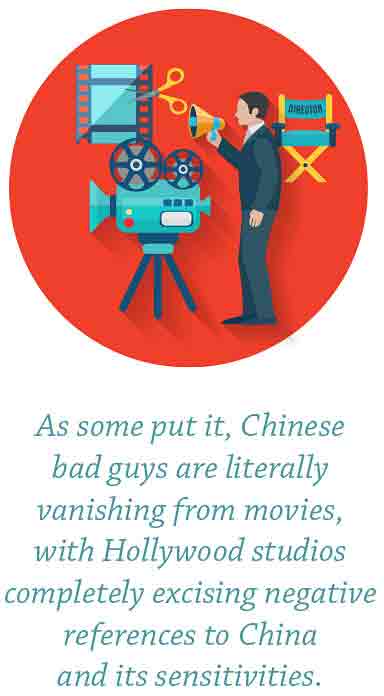
Leaked emails from Sony executives demonstrate how the process of self-censorship takes place. In the original script for the 2013 movie Pixels, aliens destroy the Great Wall. “Even though breaking a hole on the Great Wall may not be a problem as long as it is part of a worldwide phenomenon, it is actually unnecessary because it will not benefit the China release at all. I would then, recommend not to do it,” wrote the chief representative of Sony Pictures in China to senior Sony executives in 2013.158 The representative also recommended altering a scene in which US government officials speculate that “a communistconspiracy brother” might be behind some form of technological attack: “… in view of recent news on China hacking into government servers, they may object to ‘a communist-conspiracy brother hacked into the mail server,’” the executive wrote. In the final version of the film, there is no attack on the Great Wall, and the US officials speculate that Russia, Iran or Google might be behind the attack.159
POSITIVE IMAGES OF CHINA
As an interview with Chinese production company TwilightStar Entertainment makes clear, aspiring screenwriters need to proactively consider Chinese elements.
“Interestingly, American movies are sometimes made with Chinese audience in mind, knowing they’ll be subject to Chinese government censors. That leads to strategic creative picks … to prepare content for this shift, screenwriters should consider including Chinese elements, characters, location, and themes when applicable.”160
Not only are these elements unlikely to include depictions of China that offend Beijing’s sensibilities, they often show China in ways that are likely to please film censors (who are under the ultimate jurisdiction of the State Council). For instance, 2015’s Best Picture nominee The Martian (in which Chinese studio Bona Film Group had an investment),161 contained a subplot featuring a positive depiction of the China National Space Administration. Expert Chinese engineers were written into Salmon Fishing in the Yemen, although the characters did not exist in the book, while Chinese scientists were praised as visionaries by the US president’s chief of staff in the movie 2012. 162
“Because of the special situation in China’s market, we prefer to choose films with positive energy,” the chief content officer of Hunan TV & Broadcast told the Wall Street Journal.163 Hunan TV & Broadcast has co-invested in a series of films with Lions Gate. “When we choose to invest in a film,” said the executive, “our priority is to assess the film’s political and policy risks, and then its commercial prospects.”164 Overall, this approach has caused some media scholars to characterize China as the “world film police.”165
Sustained Success?
Identifying Chinese influence in Hollywood should not be confused with criticism of industry trends toward diverse talent, settings and storylines. It is not a negative thing to see Chinese and other international actors make appearances in global blockbusters. And Hollywood certainly has no perfect history when it comes to accepting or even welcoming content interference of all kinds, whether in longstanding traditions of product placement or in shaping storylines to please constituencies.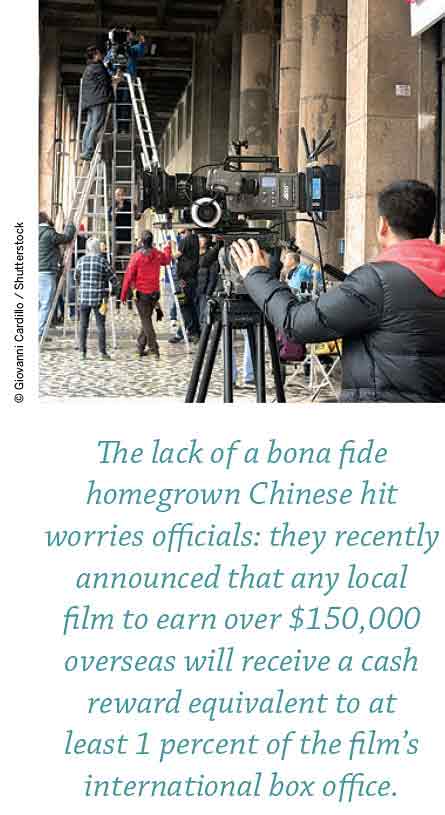
What makes this trend different is the fact that never before has a foreign power exercised such control over the content of US popular culture. Certainly, overseas investors have attempted to buy into the power of Hollywood in the past. In the late 1980s and 1990s, Japanese companies like Sony and Matsushita bought Hollywood properties, while Indian and French investors have made forays in the more recent past. But these efforts, which pale in comparison to the current number of US–China tie-ups, demonstrated only a mixed record of success. Moreover, some financial analysts think this wave of investment could be different, with Chinese investors in the United States “earning a reputation in Hollywood for being strategic, analytic and long-term focused.”166
That said, this does not necessarily guarantee future success. Concerns about an uneven playing field in China, lack of market transparency, and unclear—and shifting—regulations could threaten continued Hollywood-China partnership.167 The lack of a bona fide homegrown Chinese hit worries officials: they recently announced that any local film to earn over $150,000 overseas will receive a cash reward equivalent to at least 1 percent of the film’s international box office.168 Finally, the recent slowdown in the Chinese box office has some sector analysts concerned.169 If the Chinese domestic box office no longer looks as alluring, market logic dictates that Hollywood will abandon it for greener—and more flexible—pastures elsewhere.
Conclusion: An Information Age Power
Many of the trends examined in this essay have been underway for at least a few years. There has been considerable analysis of China’s propaganda efforts, of its growing clout in Hollywood, of its influence on the shape of the global Internet.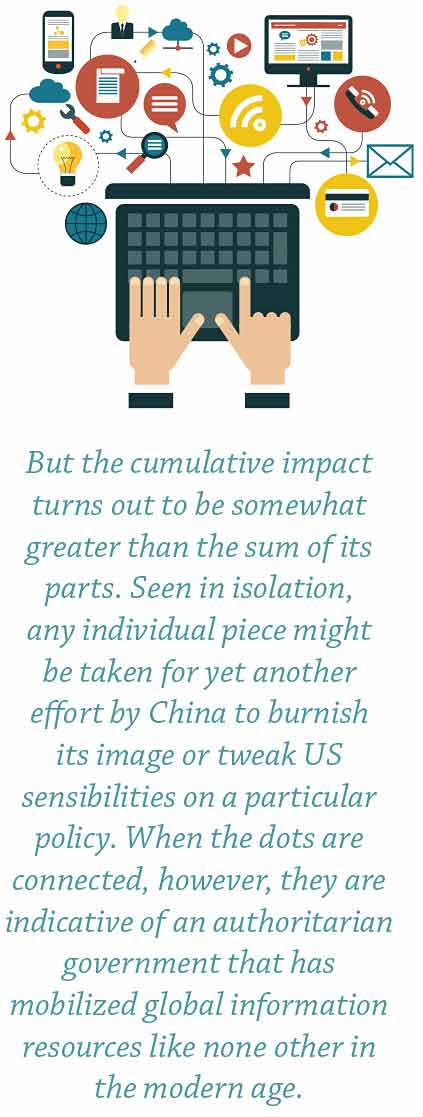
But the cumulative impact turns out to be somewhat greater than the sum of its parts. Seen in isolation, any individual piece might be taken for yet another effort by China to burnish its image or tweak US sensibilities on a particular policy. When the dots are connected, however, they are indicative of an authoritarian government that has mobilized global information resources like none other in the modern age.
The multi-pronged nature of China’s information-based strategy also ensures it remains adaptive in the face of future challenges. The ability to shift emphasis among multiple moving pieces builds resilience, thus providing a hedging mechanism against market or political uncertainty (for instance, stemming from possible fluctuations in the trade relationship between China and the United States). Moreover, because the Chinese government fundamentally grasps the connection between information and power in a holistic, long-term way, it is able to utilize this as a strategic advantage.
Analyzed together, China’s efforts across multiple sectors give rise to some crosscutting observations:
■ China’s strategy increasingly targets the information ecosystem at its source. Rather than simply trying to censor unfavorable stories or burnish its image, China is increasingly going after the infrastructure of the information ecosystem—whether through Hollywood acquisitions, the global media that informs international opinion and policy, or the norms, standards and corporate platforms powering the medium through which an ever-growing number of people in the world communicate and organize their daily lives. In doing so, China is affecting more than simply information products; it is altering the mechanisms that determine what kinds of products are produced in the first place. (This sets it apart from other governments, such as Russia, which have focused chiefly on using information-based tools to achieve influence.) The results may be anything from a global entertainment system weighted toward positive images of China to an Internet that inherently incorporates device-based surveillance and preferences the role of states.
■ Leveraging market power can have ideological benefits. Propaganda chief Liu Qibao has noted that rather than “borrowing a boat to go out onto the ocean,” as the Chinese saying goes, he recommends “buying the boat.”170 And China is, indeed, buying many boats. Around the world, Beijing—or tycoons sympathetic to Beijing’s interests—are amassing stakes in various media companies, letting the market work in their favor. In addition, several of the world’s largest Internet companies are now Chinese, and these companies are also acquiring assets and diversifying vertically, on their way to becoming multimedia global conglomerates. For Chinese companies, acquisitions and diversification are ways to grow the business and compete; for potential targets, teaming up with a Chinese company represents opportunities in the China market. Yet while individual acquisitions may depend on the logic of the market, the net result is more likely to be favorable to Beijing’s preferred ideological line than not.
■ Beijing now outsources “thought work” globally by using tactics of cooptation honed domestically. Beijing has found that its long-favored strategy of carrots and sticks to keep the private sector in line works just as well in the international arena as it does domestically. While this example can be seen perhaps most vividly in the case of Hollywood, it occurs across the board in a variety of media and communication markets. By keeping regulations vague (but the threat of retribution real), China also encourages self-censorship and self-restraint by numerous otherwise powerful entities.
■ Official propaganda remains clunky but is now less important. Because of its holistic information strategy, Beijing’s official propaganda apparatus is now complemented by the more organic spin produced by a willing host of global actors. Thus, it matters less that China Daily, CRI and other official propaganda organs are still somewhat ill at ease in the age of memes and listicles. While resources continue to be devoted to polishing up state-owned media directed overseas, Beijing appears to have learned important lessons about soft power: credibility, authenticity, and the identity of the messenger carry a great deal of weight. If these can be accomplished without the state being explicitly involved, even better. Moreover, as the global media landscape continues to evolve and traditional values of independent journalism give way to blurred lines between advertising, opinion and news, even greater opportunities for influence may emerge.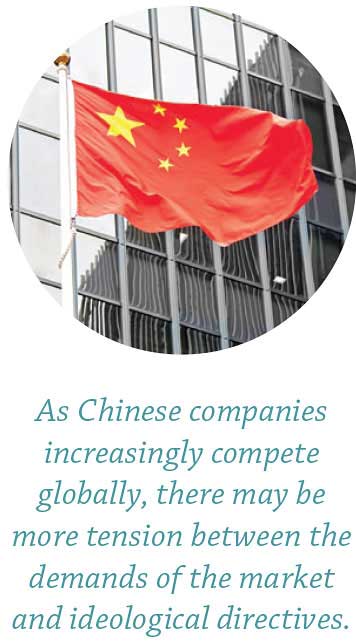
■ As Chinese companies increasingly compete globally, there may be more tension between the demands of the market and ideological directives. What remains to be seen is whether Beijing can continue to maintain ideological discipline when global consumers are driving. The global “market” generally—audiences, policymakers, civil society, consumers—is informed and savvy, and it tends to have greater expectations of trust, privacy and transparency than do domestic Chinese consumers. What happens when Chinese corporations are forced to choose between giving global consumers what they want and giving the Party what it wants? The answer is not as straightforward as it might seem, particularly if growth opportunities for some information industries lie in overseas markets. As one analyst says, “While [companies] are very aware of the ambitions of the Chinese government, they are absolutely looking to make investments that will earn an attractive return for them.”171 On the other hand, the Hollywood example has shown that, to date, Chinese corporations have not had to choose between the two (although alterations to the film quota system may have an impact at some point in the future). What is certain is that Beijing continues to learn (if sometimes in non-linear fashion) from its past missteps.
The Chinese government argues that it does not seek to overtly promote its own political system, unlike democracies engaging in democracy promotion overseas. Yet China’s growing command of the global information ecosystem is likely to result in the institutionalization of norms and standards unfavorable to democratic institutions. When the protocols of the global Internet favor device-based surveillance by states, when self-censorship by major media companies leads to a global chilling of expression, when the basic principles underlying journalism in many parts of the world preference cooperation with authority, it adds up to something like the enshrinement of authoritarian practices worldwide. That this is all happening at a time when authoritarianism is enjoying a global resurgence, even as democracies have pulled back from support for democratic institutions, gives this phenomenon added weight. If current trends continue, future historians may look back on this era as the dawning of the authoritarian information age.
Footnotes
- Shanthi Kalathil and Taylor Boas, Open Networks, Closed Regimes: The Impact of the Internet on Authoritarian Rule. (Washington, DC: Carnegie Endowment for International Peace, 2003).
- Andrew Nathan, “China’s Challenge,” in Authoritarianism Goes Global, ed. Larry Diamond, Marc Plattner, Chris Walker (Baltimore: Johns Hopkins University Press, 2016), 27
- Kalathil and Boas, Open Networks
- Anne-Marie Brady, “China’s Foreign Propaganda Machine,” in Authoritarianism Goes Global, ed. Larry Diamond, Marc Plattner, Christopher Walker (Baltimore: Johns Hopkins University Press, 2016), 187.
- Kalathil and Boas, Open Networks, 17–18
- In 2015, twelve American publishers signed a pledge to work against the censorship of foreign authors’ works in China, which is now the second-largest publishing market, behind the United States. See Amy Qin, “American Publishers Take a Stand Against Censorship in China,” The New York Times, October 15, 2015. http://sinosphere.blogs.nytimes.com/2015/10/15/china-bookscensorship-publishers/?_r=0
- Maria Repnikova and Kecheng Fang, “China’s New Media: Pushing Political Boundaries Without Being Political,” Foreign Affairs, October 12, 2016. https://www.foreignaffairs.com/articles/ china/2016-10-12/chinas-new-media
- Craig Hayden, The Rhetoric of Soft Power: Public Diplomacy in Global Contexts. (Rowman & Littlefield, 2011), 174-175.
- Hayden, Rhetoric, 171.
- Hayden, Rhetoric, 175.
- Chung-yan Chow, “Alibaba’s Jack Ma on China’s economy, Hong Kong and the South China Morning Post: full Q&A,” South China Morning Post, April 21, 2016. http://www.scmp.com/news/china/ economy/article/1937278/alibabas-jack-ma-chinas-economyhong-kong-and-south-china-morning
- R. Evan Ellis, “Chinese Soft Power in Latin America: A Case Study,” Joint Forces Quarterly, Issue 60 (2011): 86.
- Joseph Nye Jr., “Get Smart,” Foreign Affairs, July/August 2009. https://www.foreignaffairs.com/articles/2009-07-01/get-smart
- David Shambaugh, China Goes Global: The Partial Power. (New York: Oxford University Press, 2013), 5-6.
- Shambaugh, China Goes Global
- Orville Schell, “Crackdown in China: Worse and Worse.” The New York Review of Books, April 21, 2016. http://www.nybooks.com/ articles/2016/04/21/crackdown-in-china-worse-and-worse/
- “Chinese government attacks own propaganda department,” Deutsche Welle, Sept. 6, 2016, http://www.dw.com/en/chinesegovernment-attacks-own-propaganda-department/a-19318157
- Chung-yan Chow, “Alibaba’s Jack Ma.”
- 9 Ian Johnson, “Foreign Reporters in China Face More Restrictions Now, Report Says,” The New York Times, September 22, 2016. http://mobile.nytimes.com/2016/09/23/business/china-foreignmedia-pen-america.html?_r=0&referer=https://t.co/4dHwyBJM9j
- Darkened Screen: Constraints on Foreign Journalists in China. PEN America, September 22, 2016. https://pen.org/sites/default/files/ PEN_foreign_journalists_report_FINAL_online%5B1%5D.pdf
- Hayden, Rhetoric, 193.
- Sarah Cook, The Long Shadow of Chinese Censorship: How the Communist Party’s Media Restrictions Affect News Outlets Around the World Washington DC: Center for International Media Assistance, 2013), 6.
- Cook, Long Shadow, 19
- Johnson, “Foreign Reporters.”
- Sarah Cook, “Resisting Beijing’s Global Media Influence.” The Diplomat, December 10, 2015. http://thediplomat.com/2015/12/ resisting-beijings-global-media-influence/
- Brady, “China’s Foreign Propaganda Machine,” 189
- Craig Offman and Nathan Vanderklippe, “Columnist’s firing at B.C.-based Chinese paper stirs press-freedom concerns.” The Globe and Mail, June 20, 2016. http://www.theglobeandmail. com/news/national/columnists-firing-at-bc-based-chinese-paperstirs-press-freedom-concerns/article30533263/
- Paul Monk, “China’s propaganda infiltrating our shores,” The Sydney Morning Herald, July 10, 2014. http://www.smh.com. au/comment/chinas-propaganda-infiltrating-our-shores- 20140709-zt122.html
- One Country, Two Nightmares: Hong Kong Media Caught in Ideological Background. 2016 Annual Report, Hong Kong Journalists Association, July 2016. http://www.hkja.org.hk/site/ Host/hkja/UserFiles/file/annualreport/Annual_report_2016_ Final%20V.pdf
- Cook, Long Shadow, 25
- Chow, “Alibaba’s Jack Ma.”
- Tom Phillips, “Mysterious confession fuels fears of Beijing’s influence on Hong Kong’s top newspaper,” The Guardian, July 25, 2016. https://www.theguardian.com/world/2016/jul/25/southchina-morning-post-china-influence-hong-kong-newspaperconfession
- Yaqiu Wang. “As Beijing tightens grip on Hong Kong media, mainland journalists suffer,” Committee to Protect Journalists, August 15, 2016. https://cpj.org/blog/2016/08/as-beijing-tightensgrip-on-hong-kong-media-mainla.php
- Nathan, “China’s Challenge,” 28.
- Ibid.
- Brady, “China’s Foreign Propaganda Machine,” 190
- Media Oligarchs Go Shopping, Reporters Without Borders, July 2016. https://rsf.org/en/reports/media-when-oligarchs-goshopping-rsfs-latest-report
- Hayden, Rhetoric, 192.
- Brady, “China’s Foreign Propaganda Machine,” 188
- Hayden, Rhetoric, 180.
- Brady, “China’s Foreign Propaganda Machine,” 200.
- Ibid., 188
- China Watch, China Daily, October 26, 2016.
- James Fallows, “Official Chinese Propaganda: Now Online From the WaPo!” The Atlantic, February 3, 2011. http://www.theatlantic. com/international/archive/2011/02/official-chinese-propagandanow-online-from-the-wapo/70690/
- “Chinese media: Attack to defend,” Deutsche Welle, June 6, 2016. http://www.dw.com/en/chinese-media-attack-todefend/a-19337992
- Helen Clark, “China’s confusing media ties with Australia,” Deutsche Welle, August 22, 2016. http://www.dw.com/en/chinasconfusing-media-ties-with-australia/a-19492831
- “China state broadcaster rebrands in international push,” CNBC, December 31, 2016. http://www.cnbc.com/2016/12/31/chinastate-broadcaster-rebrands-in-international-push.html
- Anne Nelson, CCTV’s International Expansion: China’s Grand Strategy for Media? (Washington, DC: Center for International Media Assistance, 2013).
- “Propaganda or proper journalism? China’s media expansion in Africa,” African Arguments, August 18, 2015. http:// africanarguments.org/2015/08/18/propaganda-or-properjournalism-chinas-media-expansion-in-africa/
- Brady, “China’s Foreign Propaganda Machine,” 199.
- 1 Koh Gui Qing and John Shiffman, “Beijing’s covert radio network airs China-friendly news across Washington, and the world,” Reuters, November 2, 2015. http://www.reuters.com/investigates/ special-report/china-radio/
- Scott D. Livingston, “Assessing China’s Plan to Build Internet Power,” ChinaFile, Jan. 7, 2016. http://www.chinafile.com/reportingopinion/media/assessing-chinas-plan-build-internet-power
- Douglas Farah and Andy Mosher, Winds From the East: How the People’s Republic of China Seeks to Influence the Media in Africa, Latin America, and Southeast Asia. (Washington, DC: Center for International Media Assistance, 2010), 4.
- Ibid.
- “China’s Media Challenges Western Narratives of Africa,” ChinaFile, October 5, 2016. http://www.chinafile.com/china-africa-project/ chinas-media-challenges-western-narratives-of-africa
- Farah and Mosher, Winds From the East, 4.
- Fei Jiang, Shubo Li, Helge Rønning, Elling Tjønneland. “The voice of China in Africa: media, communication technologies and imagebuilding,” Chinese Journal of Communication 9, no. 1 (2016): 1–7
- Iginio Gagliardone, “China and the Shaping of African Information Societies,” in Aleksandra W. Gadzala, ed., Africa and China: How Africans and Their Governments are Shaping Relations with China (Rowman & Littlefield, 2015), 48
- Farah and Mosher, Winds From the East, 16.
- “Propaganda or proper journalism? China’s media expansion in Africa,” African Arguments, Aug. 18, 2015. http://africanarguments. org/2015/08/18/propaganda-or-proper-journalism-chinas-mediaexpansion-in-africa/
- Beijing Review, “Understanding China Through Keywords,” Sept. 15, 2016. http://www.bjreview.com/Lifestyle/201609/ t20160912_800067471.html
- Livingston, “Assessing China’s Plan.”
- Shambaugh, China Goes Global, 125
- Paul R. Burgman Jr., “Securing Cyberspace: China Leading the Way in Cyber Sovereignty,” The Diplomat, May 18, 2016. http:// thediplomat.com/2016/05/securing-cyberspace-china-leadingthe-way-in-cyber-sovereignty/
- William J. Drake, Vinton G. Cerf, and Wolfgang Kleinwächter, “Internet Fragmentation: An Overview,” Future of the Internet Initiative White Paper (World Economic Forum, 2016), 31.
- Mark Raymond and Laura DeNardis. Multi-stakeholderism: Anatomy of an Inchoate Global Institution, Paper Series: no. 41 (Global Commission on Internet Governance, 2016). https://www. cigionline.org/sites/default/files/gcig_no.41web.pdf
- Lu, Wei. “Cyber Sovereignty Must Rule Global Internet,” February 14, 2015. http://www.huffingtonpost.com/lu-wei/china-cybersovereignty_b_6324060.html
- Farhad Manjoo, “Why the World Is Drawing Battle Lines Against American Tech Giants,” The New York Times, June 1, 2016. http:// www.nytimes.com/2016/06/02/technology/why-the-world-isdrawing-battle-lines-against-american-tech-giants.html?smid=twshare
- Shai Oster, “Whose Internet Is It Anyway? China Wields More Influence,” Bloomberg, November 20, 2014. https://www. bloomberg.com/news/articles/2014-11-21/whose-internet-is-itanyway-china-wields-more-influence?hootPostID=f8cf8a806dec1d 20b0399cfcd248fe66
- Adam Segal, “Holding the Multistakeholder Line at the ITU,” Council on Foreign Relations, Oct. 21, 2014. http://www.cfr.org/ internet-policy/holding-multistakeholder-line-itu/p33644
- Scott Malcolmson, “How Russia and China Are Cooperating to Dismantle America’s Dominance of the Internet,” The World Post, May 5, 2016. http://www.huffingtonpost.com/ scott-malcomson/russia-china-internet_b_9841670.html?utm_ source=DMM+05%2F27%2F16&utm_campaign=DMM+12- 18&utm_medium=email
- Segal, “Holding the Multistakeholder Line.”
- Livingston, “Assessing China’s Plan.”
- Jun Mai, “China’s former internet tsar Lu Wei comes out of the shadows after three months—in new role,” South China Morning Post, October 21, 2016. http://www.scmp.com/news/china/ policies-politics/article/2024316/chinas-former-internet-tsar-luwei-comes-out-shadows
- China Media Bulletin Issue No. 116, Freedom House, September 2016. https://freedomhouse.org/china-media/china-mediabulletin-issue-no-116-september-2016
- Segal, “Holding the Multistakeholder Line.”
- Ibid.
- Dan Levin, “At U.N., China Tries to Influence Fight Over Internet Control,” The New York Times, December 16, 2015. http://www. nytimes.com/2015/12/17/technology/china-wins-battle-with-unover-word-in-internet-control-document.html
- Franz-Stefan Gady, The Wuzhen Summit and the Battle over Internet Governance,” The Diplomat, January 14, 2016. http:// thediplomat.com/2016/01/the-wuzhen-summit-and-the-battleover-internet-governance/
- Ibid.
- Paul Mozur and Jane Perlez, “Gregarious and Direct: China’s Web Doorkeeper,” The New York Times, December 1, 2014. http://www. nytimes.com/2014/12/02/world/asia/gregarious-and-directchinas-web-doorkeeper.html
- Adam Segal, “China’s Internet Conference: Xi Jinping’s Message to Washington,” Council on Foreign Relations, December 16, 2015. http://blogs.cfr.org/cyber/2015/12/16/chinas-internet-conferencexi-jinpings-message-to-washington/
- Robert M. McDowell and Gordon M. Goldstein, “The Authoritarian Internet Power Grab,” The Wall Street Journal, October 25, 2016. http://www.wsj.com/articles/the-authoritarian-internet-powergrab-1477436573
- Simon Denyer, “China’s scary lesson to the world: Censoring the Internet works,” The Washington Post, May 23, 2016. https://www.washingtonpost.com/world/asia_pacific/ chinas-scary-lesson-to-the-world-censoring-the-internetworks/2016/05/23/413afe78-fff3-11e5-8bb1-f124a43f84dc_story. html?postshare=8371464052176221&tid=ss_tw
- Safe Internet Forum Program. http://safeinternetforum.ru/en/ programma/
- Ron Diebert, “Cyberspace Under Siege,” in Diamond, et al., eds., Authoritarianism Goes Global, 203.
- Ibid.
- Livingston, Scott D. “Assessing China’s Plan.”
- J. Michael Daniel, Robert Holleyman, Robert, and Alex Niejelow, Alex. “China’s Undermining an Open Internet,” Politico, February 4, 2015. http://www.politico.com/magazine/story/2015/02/chinacybersecurity-114875#.VNJDa8bov4k
- Tim Maurer and Robert Morgus, “‘Cybersecurity’ and Why Definitions Are Risky,” Center for Security Studies, November 10, 2014. http://isnblog.ethz.ch/intelligence/cybersecurity-and-theproblem-of-definitions
- Denyer, “China’s scary lesson.”
- “China’s 13th Five-Year Plan: Q&A with Scott Kennedy and Christopher K. Johnson,” The Wall Street Journal, May 23, 2016. http://blogs.wsj.com/chinarealtime/2016/05/23/chinas-13th-fiveyear-plan-qa-with-scott-kennedy-and-christopher-k-johnson/
- Yue Hu. “Internet Plus Sets the Trend,” China Today, May 11, 2016. http://www.chinatoday.com.cn/english/report/2016-05/11/ content_720462.htm
- Livingston, “Assessing China’s Plan.”
- Quan Yuan, Qiao Han, Xu Chao. “China Headlines: A decade in two 5-year plans,” Xinhua, March 16, 2016. http://news.xinhuanet.com/ english/2016-03/16/c_135194648.htm
- Nathan Freitas, “People Around the World Are Voluntarily Submitting to China’s Great Firewall. Why?” Slate, January 6, 2015. http://www.slate.com/blogs/future_tense/2015/01/06/tencent_s_ wechat_worldwide_internet_users_are_voluntarily_submitting_ to.html
- Ibid.
- Jane Perlez and Paul Mozur, “Lu Wei, China’s Internet Czar, Will Step Down From Post,” The New York Times, June 29, 2016. http://www.nytimes.com/2016/06/30/business/international/ china-internet-lu-wei.html
- Tim Maurer, “What’s Next for the US and China in Cybersecurity,” The Wall Street Journal, July 5, 2016. http://carnegieendowment. org/2016/07/05/what-s-next-for-US-and-china-in-cybersecuritypub-64144
- Hayden, Rhetoric, p. 196
- “China’s Film Industry: A Blockbuster in the Making,” Knowledge@Wharton, Feb. 17, 2016. http://knowledge.wharton. upenn.edu/article/lights-china-action-how-china-is-getting-intothe-global-entertainment-business/
- “Hollywood and Chinese Cinema: The Future of Movies, The Huffington Post, July 5, 2016.
- “China’s Film Industry,” Knowledge@Wharton.
- Ibid.
- “Hollywood and Chinese Cinema,” The Huffington Post.
- Patrick Brzeski, “China Box-Office Growth Slowed to 3.7 Percent in 2016, Official Data Shows,” The Hollywood Reporter, January 1, 2017. http://www.hollywoodreporter.com/news/china-box-officegrowth-slows-37-percent-2016-official-data-shows-960217
- Stanley Rosen, “Hollywood in China: Selling Out or Cashing In?,” The Diplomat, May 26, 2015. http://thediplomat.com/2015/05/ hollywood-in-china-selling-out-or-cashing-in/
- Bryan Bishop,“Warcraft’s record-breaking opening in China may be the future of Hollywood blockbusters,” The Verge, June 13, 2016. http://www.theverge.com/2016/6/13/11924774/warcraftmovie-box-office-record-debut-china-sequel-hollywood-future
- Sean O’Connor and Nicholas Armstrong, “Directed by Hollywood, Edited by China: How China’s Censorship and Influence Affect Films Worldwide,” US-China Economic and Security Review Commission, October 28, 2015, p.4.
- Rosen, “Hollywood in China.”
- Patrick Frater,“Chinese Regulators to Allow Hollywood Films in Summer,” Variety, July 8, 2016. http://variety.com/2016/ film/asia/chinese-regulators-to-allow-hollywood-films-insummer-1201810624/
- O’Connor, Sean et al., “Directed by Hollywood.”
- Clare Baldwin and Kristina Cooke, “How Sony sanitized the new Adam Sandler movie to please Chinese censors,” Reuters, July 24, 2015. http://www.reuters.com/investigates/special-report/ china-film/
- Dominick Suzanne-Mayer, “China, Hollywood, and the Global Future of Film Production,” Consequence of Sound, August 5, 2016. http://consequenceofsound.net/2016/08/china-hollywoodand-the-global-future-of-film-production/
- Ibid.
- Frater, “Chinese Regulators.”
- Ibid.
- Baldwin, et al. “How Sony sanitized.”
- Priest, “Copyright and Free Expression.”
- O’Connor, Sean et al., “Directed by Hollywood.”
- Benjamin Lee, “Eastern promise: the Hollywood films making their money in China,” The Guardian, June 14, 2016. https://www.theguardian.com/film/filmblog/2016/jun/14/ hollywood-films-in-china-asia-market-warcraft-the-beginning
- Bishop, “Warcraft’s record-breaking opening.”
- Ibid.
- Jun Wang, “Beijing’s Hollywood Debut.” Beijing Review, Feb. 25, 2016.
- Matt Pressberg, “Chinese Studio Exec Lays Out Everything Hollywood Does Wrong,” The Wrap, September 15, 2016. http:// www.thewrap.com/chinese-le-vision-exec-lays-out-everythinghollywood-does-wrong/
- Nancy Tartaglione, “‘The Great Wall’ Scales $24.3M In First Day Of China Release,” Deadline.com, December 16, 2016. http://deadline.com/2016/12/the-great-wall-china-opening-boxoffice-matt-damon-1201872165/
- “Coming to a Theater Near You: Made-in-China Disney Movies,” Bloomberg News, June 9, 2016. http://www.bloomberg.com/news/ articles/2016-06-09/coming-soon-to-a-theater-near-you-made-inchina-disney-movies
- Priest, “Copyright and Free Expression.”
- Brooks Barnes, “STX, Hollywood Start-Up Behind ‘Bad Moms,’ Gains Chinese Investors,” The New York Times, Aug 11, 2016. http://www.nytimes.com/2016/08/12/business/media/stx-anentertainment-start-up-gains-chinese-investors.html
- Ibid.
- Matthew Garrahan and Henny Sender, “Chinese Investors Flood Into Hollywood,” Financial Times, June 7, 2016. https://www.ft.com/ content/2cb93908-2c65-11e6-bf8d-26294ad519fc
- Rebecca Fannin, “Tencent’s Hollywood Deal With STX Extends China Reach Beyond Tech,” Forbes, August 12, 2016. http://www.forbes.com/sites/rebeccafannin/2016/08/12/ tencents-hollywood-deal-with-stx-extends-china-reach-beyondtech/#86a6d6b1ca1d
- Pressberg, “Chinese Studio Exec.”
- Scott Cendrowski, “China’s Richest Man Is Going After Hollywood Studio Paramount,” Fortune, July 14, 2016. http://fortune. com/2016/07/14/dalian-wanda-hollywood-paramount/
- Erich Schwartzel and Kathy Chu, “China’s Influence on Hollywood Grows,” The Wall Street Journal, July 14, 2016. http://www.wsj.com/ articles/chinas-influence-on-hollywood-grows-1468519130
- “The Man Who Wants to Take Hollywood to China,” Reuters, August 23, 2016. http://nypost.com/2016/08/23/the-man-whowants-to-take-hollywood-to-china/
- Stephen Evans, “China’s Hollywood studio buy-up begs questions,” BBC, Jan. 12, 2016. http://www.bbc.com/news/world-asiachina-35290404
- Michael Forsythe, “Wang Jianlin, a Billionaire at the Intersection of Business and Power in China,” The New York Times, April 28, 2015. http://www.nytimes.com/2015/04/29/world/asia/wang-jianlinabillionaire-at-the-intersection-of-business-and-power-in-china. html?_r=0
- Cendrowski, “China’s Richest Man.”
- Joanna Robinson, “Did You Catch All the Ways Hollywood Pandered to China This Year?” Vanity Fair, August 5, 2016. http://www.vanityfair.com/hollywood/2016/08/did-you-catch-theways-hollywood-pandered-to-china-this-year
- Gus Lubin, “18 Hollywood Movies That Pandered to China’s Giant Box Office,” Business Insider, October 14, 2016. http://www.businessinsider.com/hollywood-movies-inchina-2016-10
- Baldwin, et al. “How Sony sanitized.”
- Rosen, “Hollywood in China.”
- Robinson, “Did You Catch.”
- Schwartzel, et al. “China’s Influence.”
- “Independence Day: Resurgence Main Characters Use QQ IM Service for Video Call between the Earth and the Moon,” PR Newswire, June 27, 2016. http://www.prnewswire.com/ news-releases/independence-day-resurgence-main-charactersuse-qq-im-service-for-video-call-between-the-earth-and-themoon-300290395.html
- Xi Wei, “Chinese audiences unhappy with clumsy product placement,” Global Times, June 29, 2016. http://www.globaltimes. cn/content/991371.shtml
- Lee, “Eastern promise.”
- Ibid.
- Amy Qin, “Pander or Diversify? Hollywood Courts China With ‘The Great Wall’,” The New York Times, January 19, 2017. https://www.nytimes.com/2017/01/19/movies/the-great-wallmatt-damon-chinese-box-office.html
- McDonald, Mark. “Beijing’s Censors Could Test the Mettle of Iron Man,” The International Herald Times, July 17, 2012. http:// rendezvous.blogs.nytimes.com/2012/07/17/beijings-censorscould-test-the-mettle-of-iron-man/
- Lubin, “18 Hollywood Movies.”
- Lee, “Eastern promise.”
- Williams, Holly. “Rising in the East,” 60 Minutes, April 10, 2016. http://www.cbsnews.com/news/60-minutes-china-film-industrybooming/
- McDonald, “Beijing’s Censors.”
- Lubin, “18 Hollywood Movies.
- Langfitt, Frank. “How China’s Censors Influence Hollywood,” NPR, May 18, 2015. http://www.npr.org/sections/ parallels/2015/05/18/407619652/how-chinas-censors-influencehollywood
- Baldwin, et al. “How Sony sanitized.”
- Ibid.
- “Hollywood and Chinese Cinema,” The Huffington Post
- Ibid.
- McDonald, “Beijing’s Censors.”
- Schwartzel, et al. “China’s Influence.”
- Ibid.
- Langfitt, “How China’s Censors Influence.”
- Garrahan, et al. “Chinese Investors Flood.”
- Tartaglione, Nancy. “Is ‘Warcraft’s Outsized China Box Office A Game-Changer For Hollywood?” Deadline Hollywood, June 15, 2016. http://deadline.com/2016/06/warcraft-box-office-analysischina-future-1201772400/
- Stout, Kristie Lu. “Blockbuster battle: Is China’s movie industry the new Hollywood?” CNN, June 23, 2016. http://www.cnn. com/2016/06/23/asia/china-entertainment-movie-industry/
- Brzeski, Patrick. “What’s Behind China’s Sudden Box-Office Slump?” The Hollywood Reporter, July 20, 2016. http://www.hollywoodreporter.com/news/whats-behind-chinassudden-box-912718
- Brady, “China’s Foreign Propaganda Machine,” 194.
- China’s Film Industry, Knowledge@Wharton.


